Automated Control Systems - Actuators and PLCs
VerifiedAdded on 2021/04/09
|25
|1934
|139
AI Summary
This assignment delves into the world of automated control systems, covering the essential aspects of actuators and Programmable Logic Controllers (PLCs). It begins with a detailed explanation of linear and rotary actuators, including their definitions, functionality, and specifications. The discussion then shifts to control methods, highlighting two prominent approaches - Arduino Uno and PLCs. A comprehensive overview of PLCs is provided, covering their definition, why they are used in automation industries, types (compact and modular), and specifications. This assignment serves as a valuable resource for students seeking to understand the fundamentals of automated control systems.
Contribute Materials
Your contribution can guide someone’s learning journey. Share your
documents today.
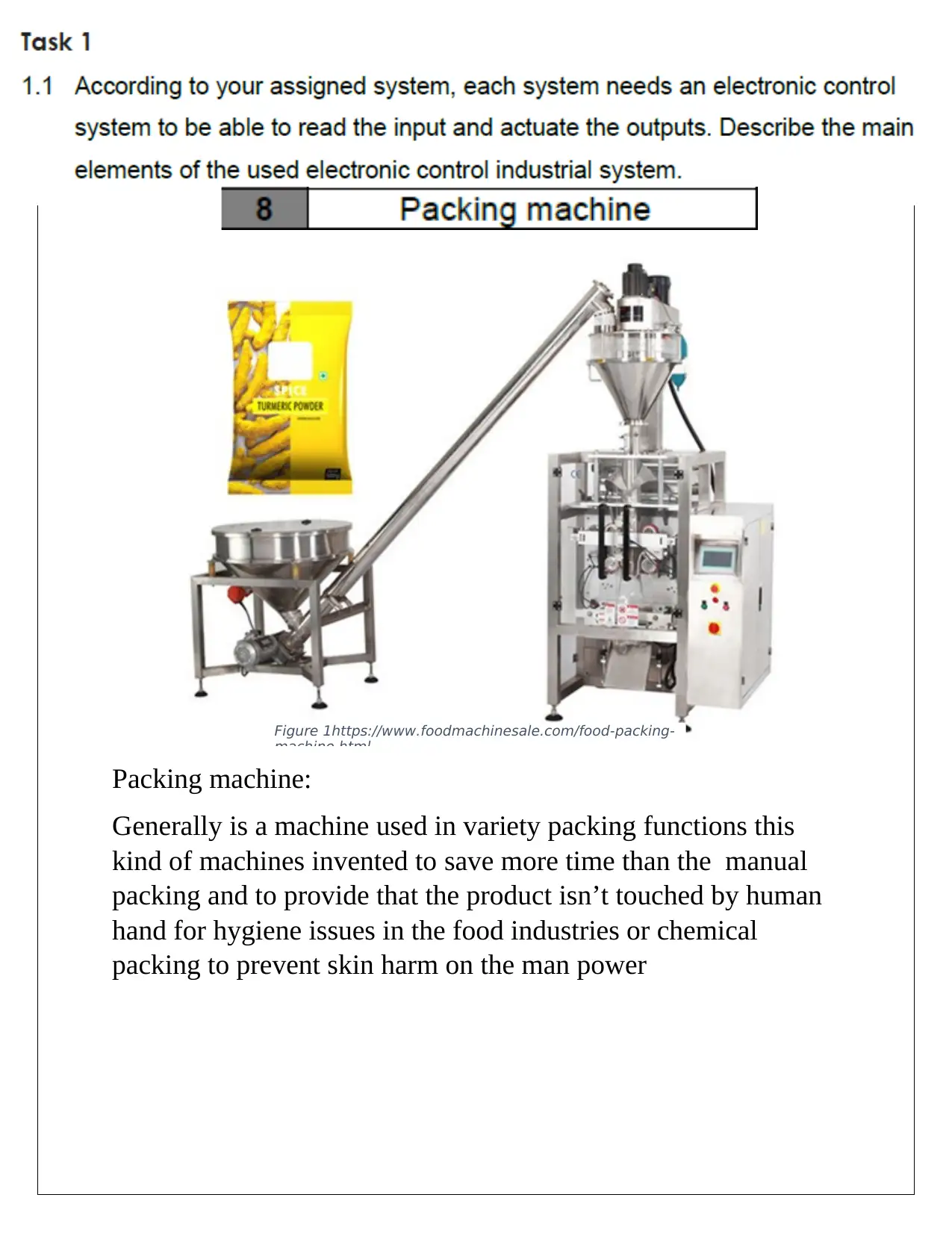
Packing machine:
Generally is a machine used in variety packing functions this
kind of machines invented to save more time than the manual
packing and to provide that the product isn’t touched by human
hand for hygiene issues in the food industries or chemical
packing to prevent skin harm on the man power
Figure 1https://www.foodmachinesale.com/food-packing-
machine.html
Generally is a machine used in variety packing functions this
kind of machines invented to save more time than the manual
packing and to provide that the product isn’t touched by human
hand for hygiene issues in the food industries or chemical
packing to prevent skin harm on the man power
Figure 1https://www.foodmachinesale.com/food-packing-
machine.html
Secure Best Marks with AI Grader
Need help grading? Try our AI Grader for instant feedback on your assignments.
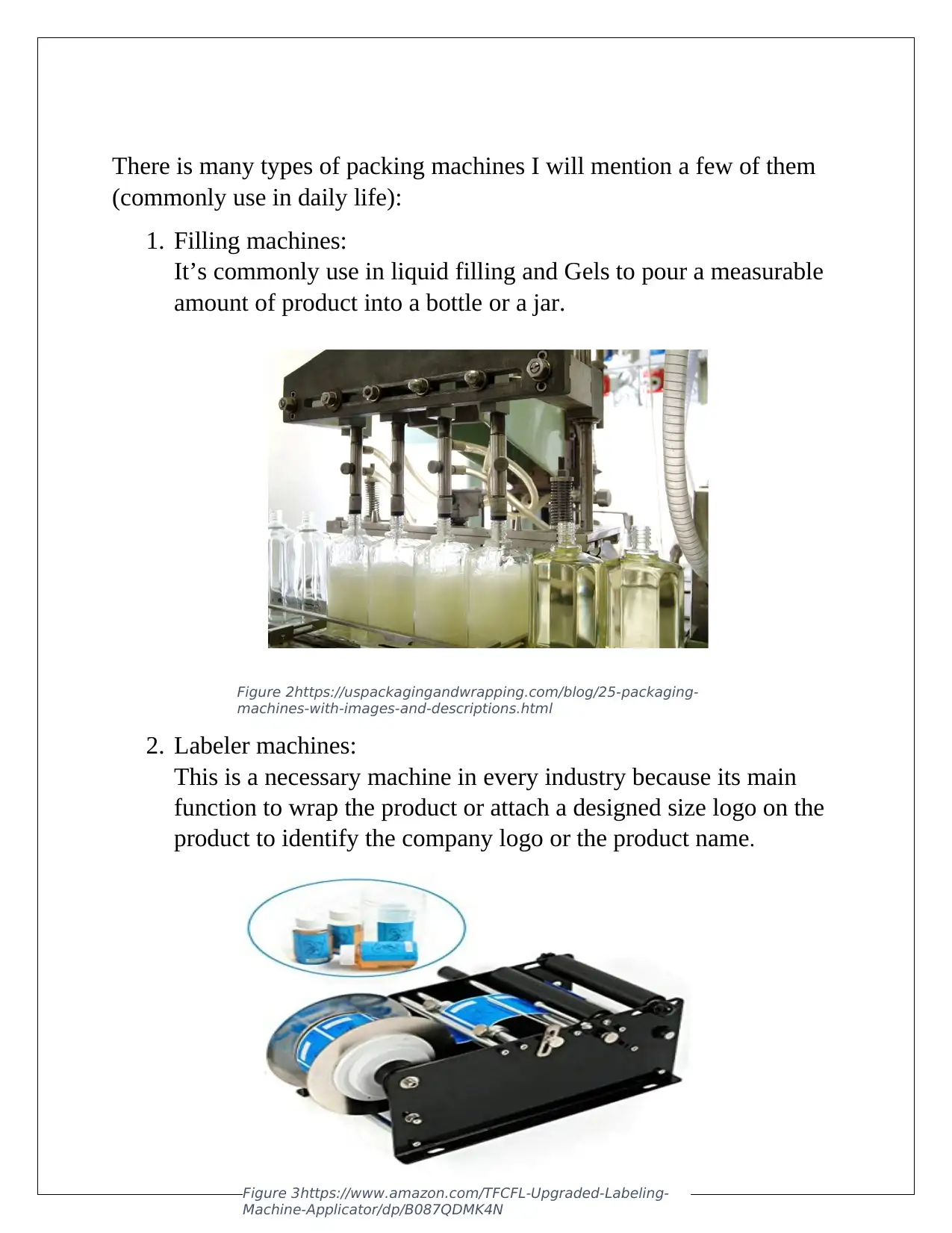
There is many types of packing machines I will mention a few of them
(commonly use in daily life):
1. Filling machines:
It’s commonly use in liquid filling and Gels to pour a measurable
amount of product into a bottle or a jar.
2. Labeler machines:
This is a necessary machine in every industry because its main
function to wrap the product or attach a designed size logo on the
product to identify the company logo or the product name.
Figure 2https://uspackagingandwrapping.com/blog/25-packaging-
machines-with-images-and-descriptions.html
Figure 3https://www.amazon.com/TFCFL-Upgraded-Labeling-
Machine-Applicator/dp/B087QDMK4N
(commonly use in daily life):
1. Filling machines:
It’s commonly use in liquid filling and Gels to pour a measurable
amount of product into a bottle or a jar.
2. Labeler machines:
This is a necessary machine in every industry because its main
function to wrap the product or attach a designed size logo on the
product to identify the company logo or the product name.
Figure 2https://uspackagingandwrapping.com/blog/25-packaging-
machines-with-images-and-descriptions.html
Figure 3https://www.amazon.com/TFCFL-Upgraded-Labeling-
Machine-Applicator/dp/B087QDMK4N
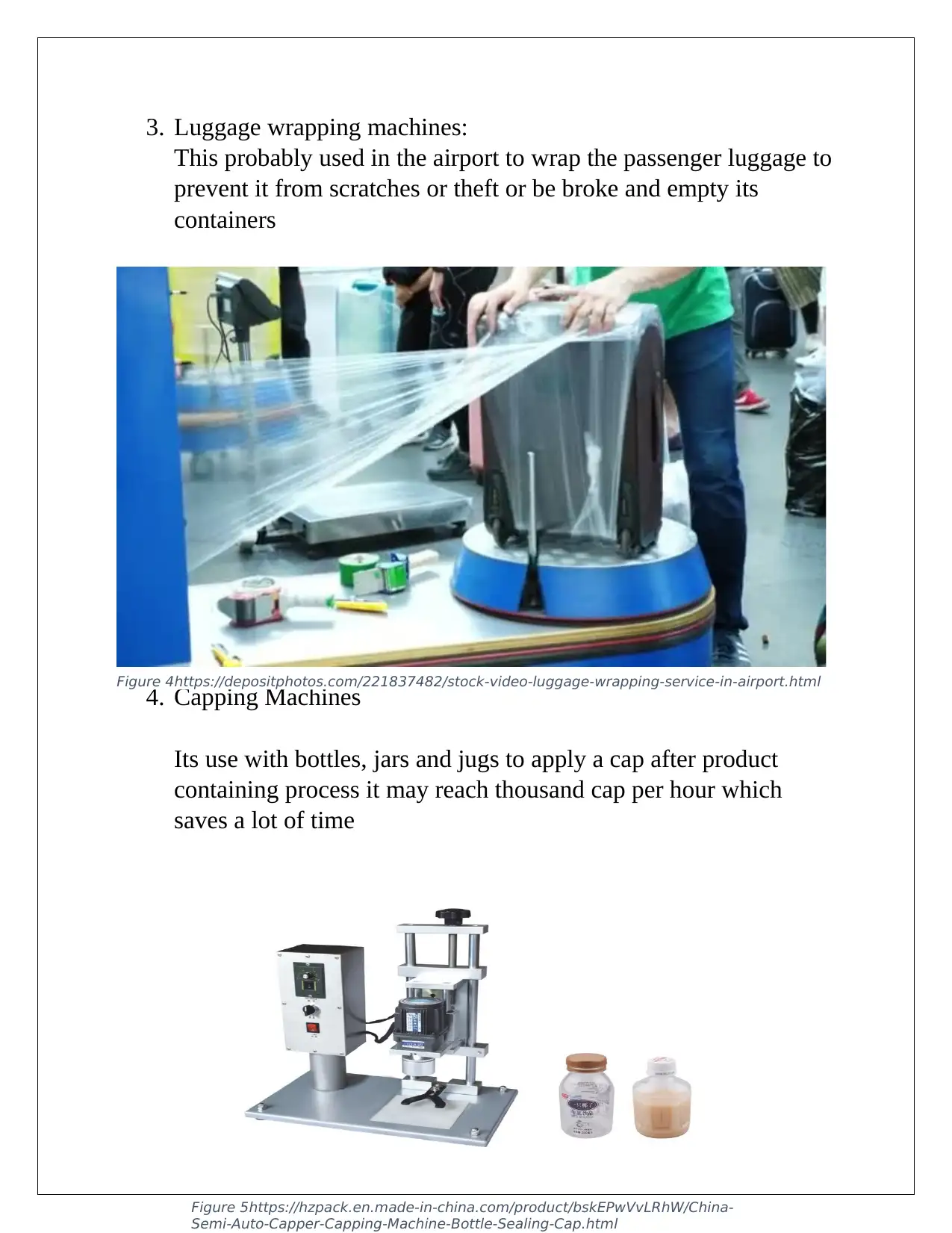
3. Luggage wrapping machines:
This probably used in the airport to wrap the passenger luggage to
prevent it from scratches or theft or be broke and empty its
containers
4. Capping Machines
Its use with bottles, jars and jugs to apply a cap after product
containing process it may reach thousand cap per hour which
saves a lot of time
Figure 4https://depositphotos.com/221837482/stock-video-luggage-wrapping-service-in-airport.html
Figure 5https://hzpack.en.made-in-china.com/product/bskEPwVvLRhW/China-
Semi-Auto-Capper-Capping-Machine-Bottle-Sealing-Cap.html
This probably used in the airport to wrap the passenger luggage to
prevent it from scratches or theft or be broke and empty its
containers
4. Capping Machines
Its use with bottles, jars and jugs to apply a cap after product
containing process it may reach thousand cap per hour which
saves a lot of time
Figure 4https://depositphotos.com/221837482/stock-video-luggage-wrapping-service-in-airport.html
Figure 5https://hzpack.en.made-in-china.com/product/bskEPwVvLRhW/China-
Semi-Auto-Capper-Capping-Machine-Bottle-Sealing-Cap.html
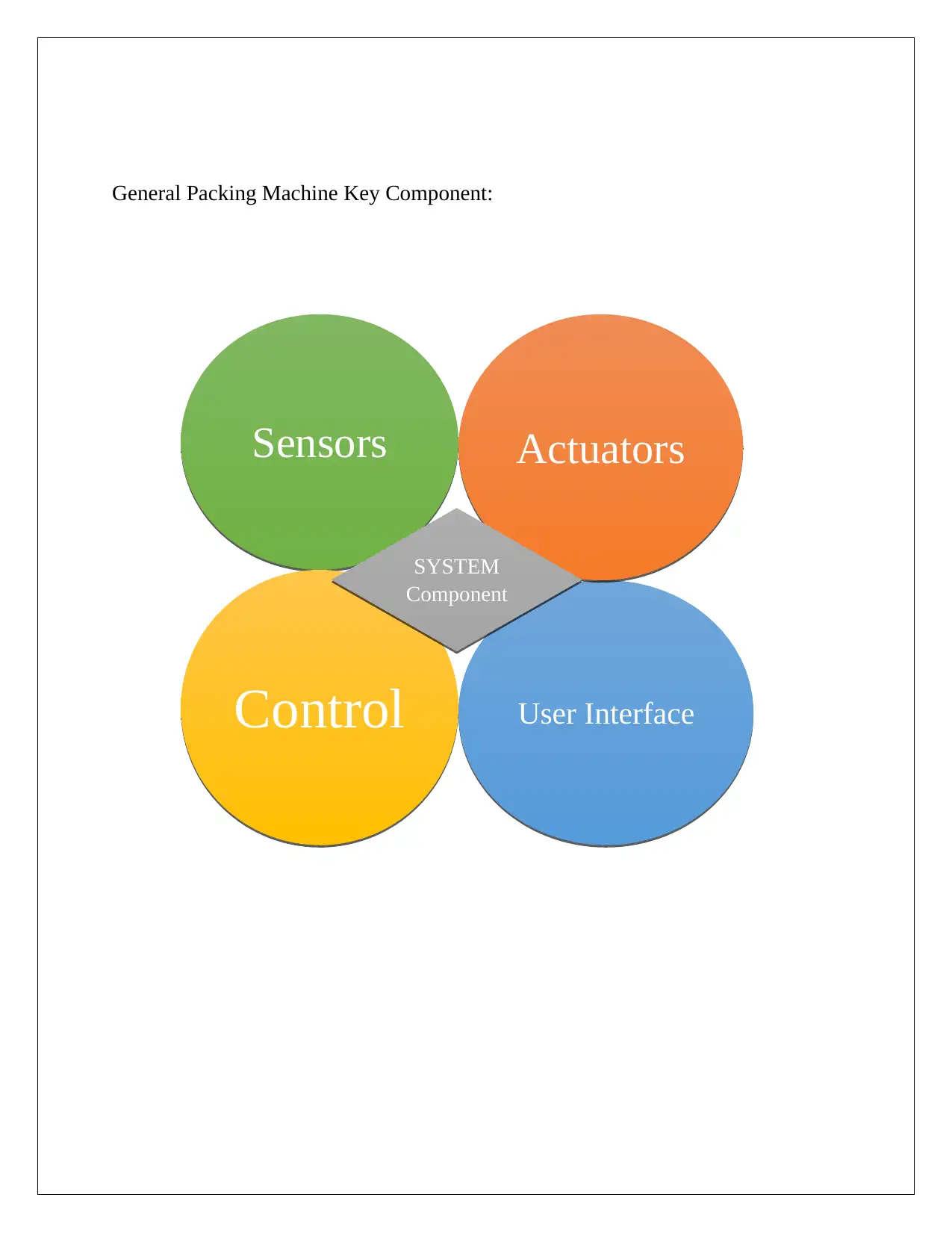
General Packing Machine Key Component:
User InterfaceControl
Sensors Actuators
SYSTEM
Component
User InterfaceControl
Sensors Actuators
SYSTEM
Component
Secure Best Marks with AI Grader
Need help grading? Try our AI Grader for instant feedback on your assignments.
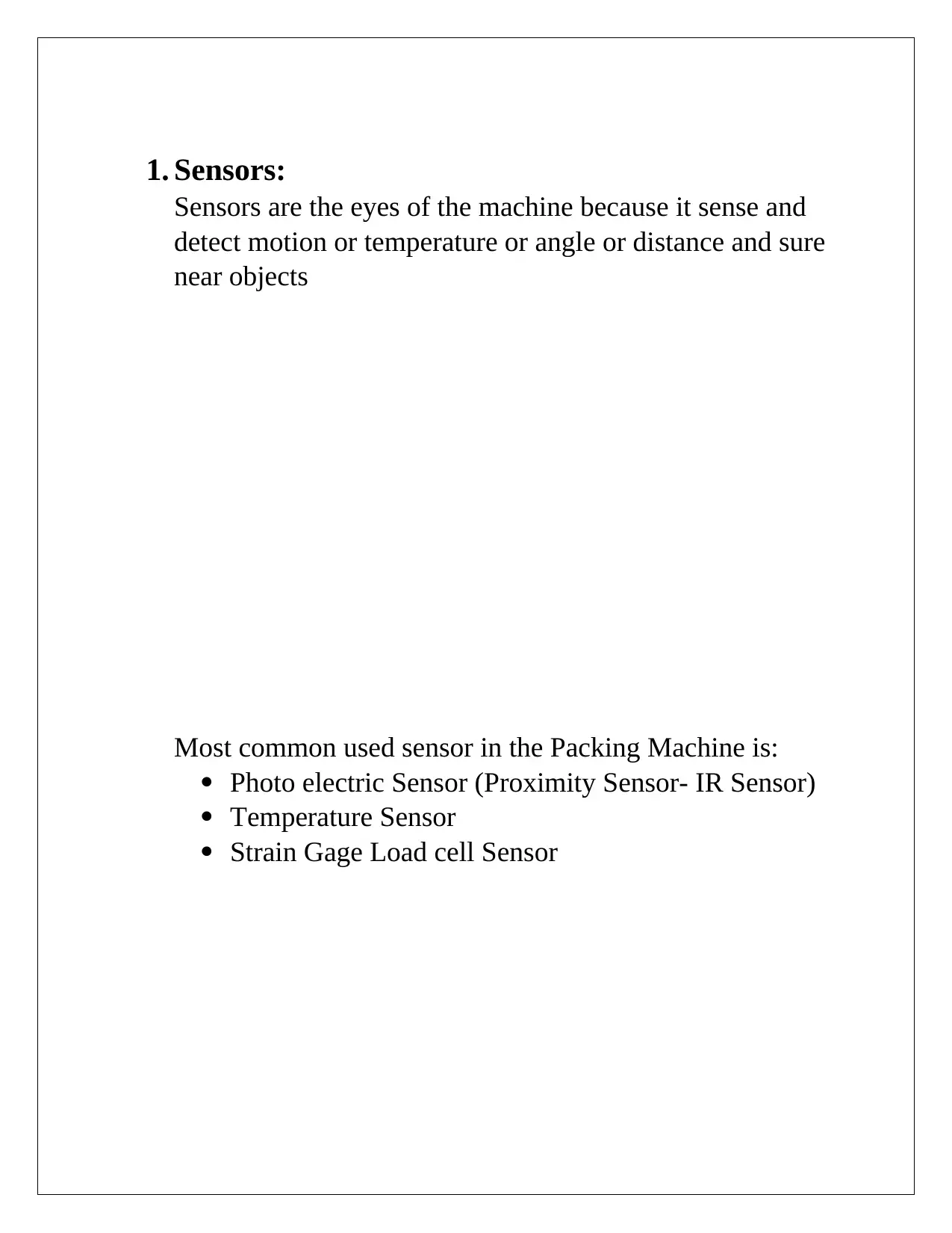
1. Sensors:
Sensors are the eyes of the machine because it sense and
detect motion or temperature or angle or distance and sure
near objects
Most common used sensor in the Packing Machine is:
Photo electric Sensor (Proximity Sensor- IR Sensor)
Temperature Sensor
Strain Gage Load cell Sensor
Sensors are the eyes of the machine because it sense and
detect motion or temperature or angle or distance and sure
near objects
Most common used sensor in the Packing Machine is:
Photo electric Sensor (Proximity Sensor- IR Sensor)
Temperature Sensor
Strain Gage Load cell Sensor
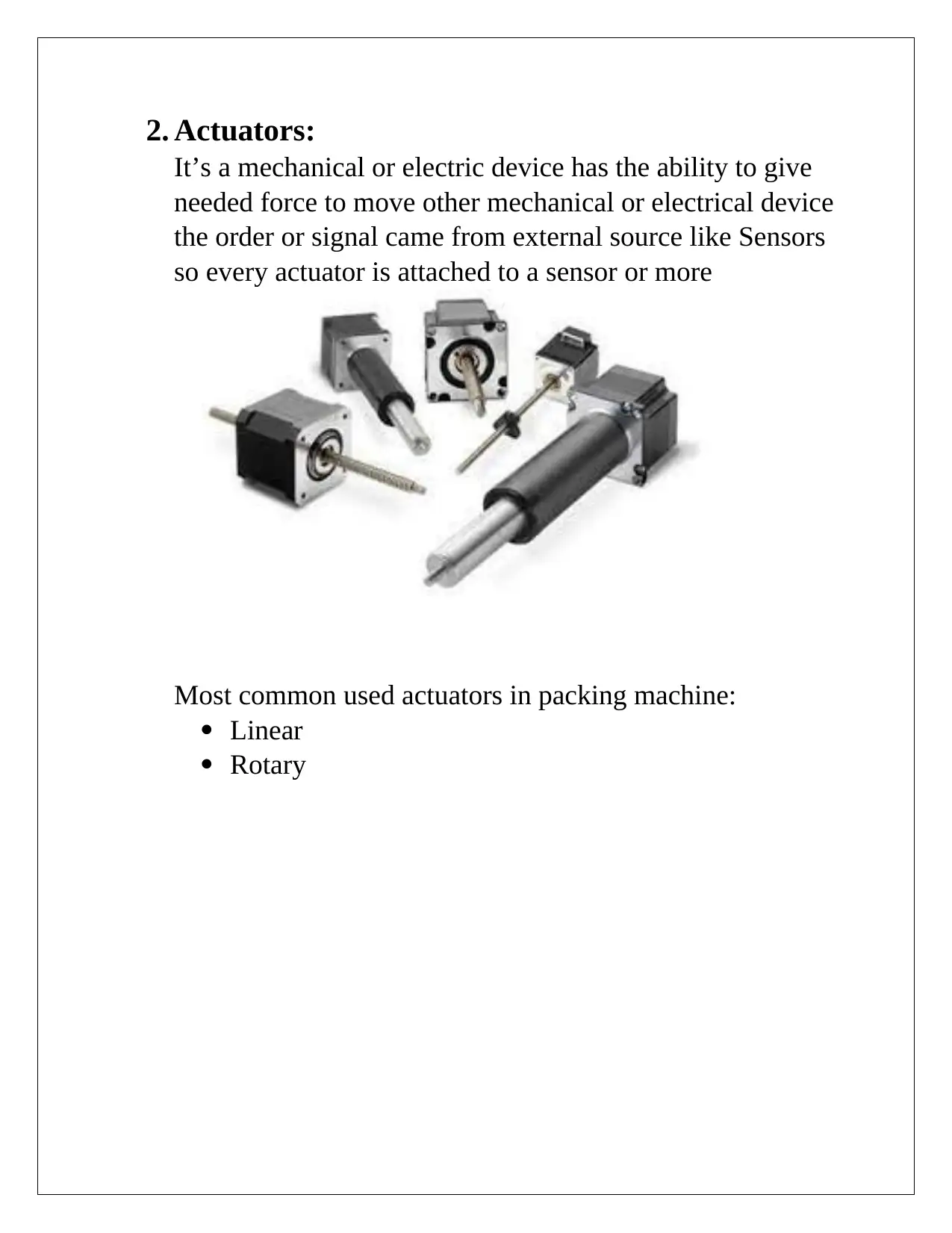
2. Actuators:
It’s a mechanical or electric device has the ability to give
needed force to move other mechanical or electrical device
the order or signal came from external source like Sensors
so every actuator is attached to a sensor or more
Most common used actuators in packing machine:
Linear
Rotary
It’s a mechanical or electric device has the ability to give
needed force to move other mechanical or electrical device
the order or signal came from external source like Sensors
so every actuator is attached to a sensor or more
Most common used actuators in packing machine:
Linear
Rotary
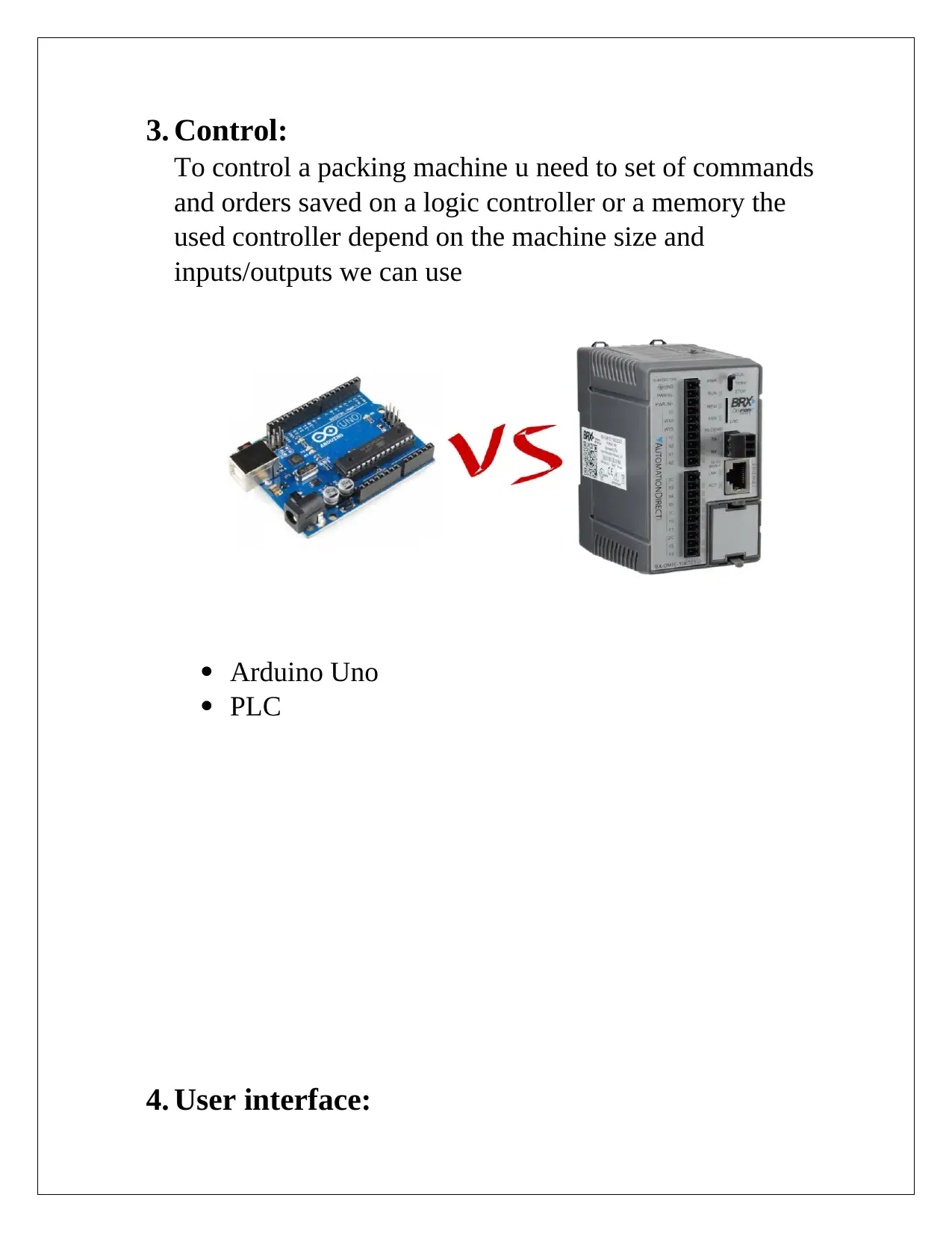
3. Control:
To control a packing machine u need to set of commands
and orders saved on a logic controller or a memory the
used controller depend on the machine size and
inputs/outputs we can use
Arduino Uno
PLC
4. User interface:
To control a packing machine u need to set of commands
and orders saved on a logic controller or a memory the
used controller depend on the machine size and
inputs/outputs we can use
Arduino Uno
PLC
4. User interface:
Paraphrase This Document
Need a fresh take? Get an instant paraphrase of this document with our AI Paraphraser
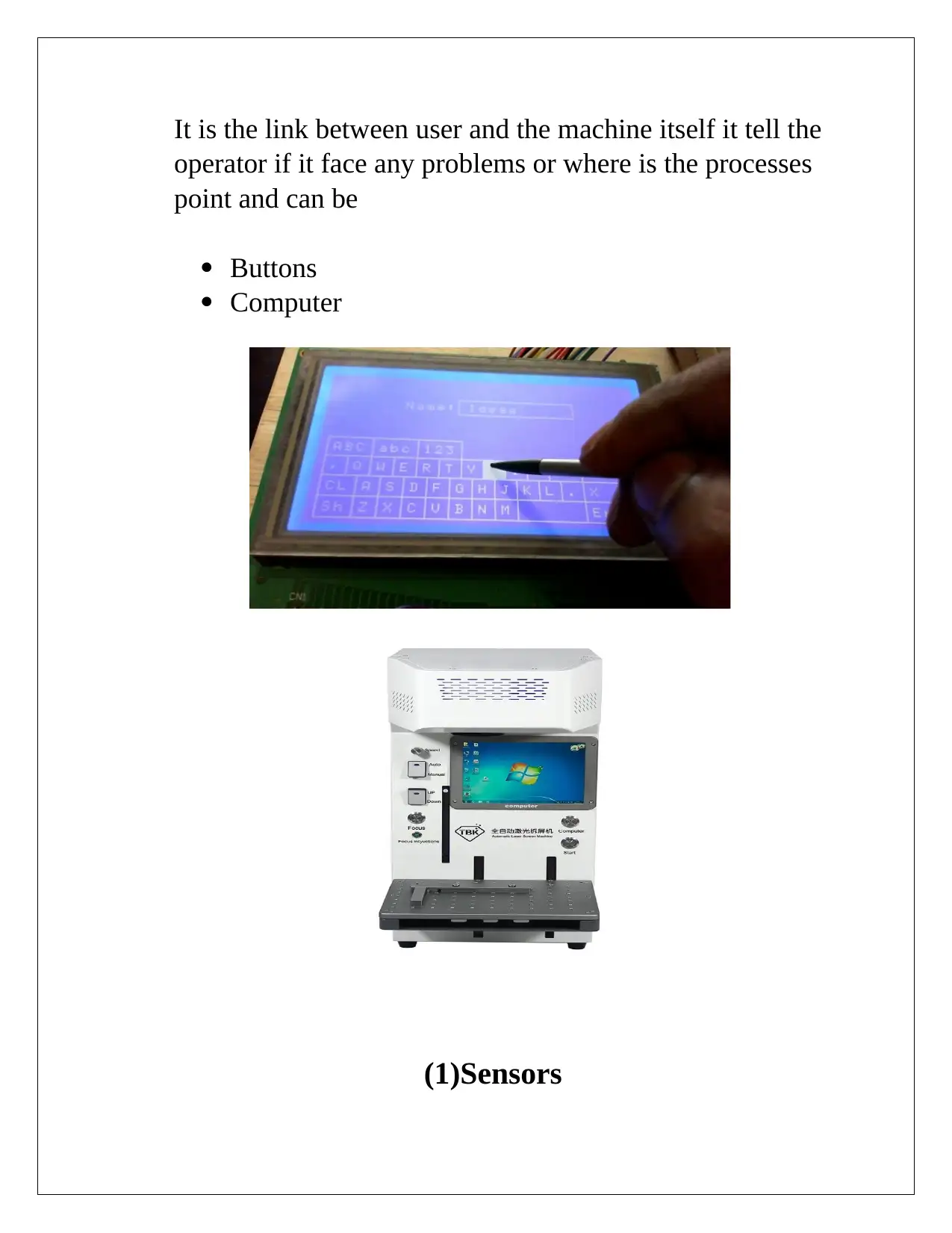
It is the link between user and the machine itself it tell the
operator if it face any problems or where is the processes
point and can be
Buttons
Computer
(1)Sensors
operator if it face any problems or where is the processes
point and can be
Buttons
Computer
(1)Sensors
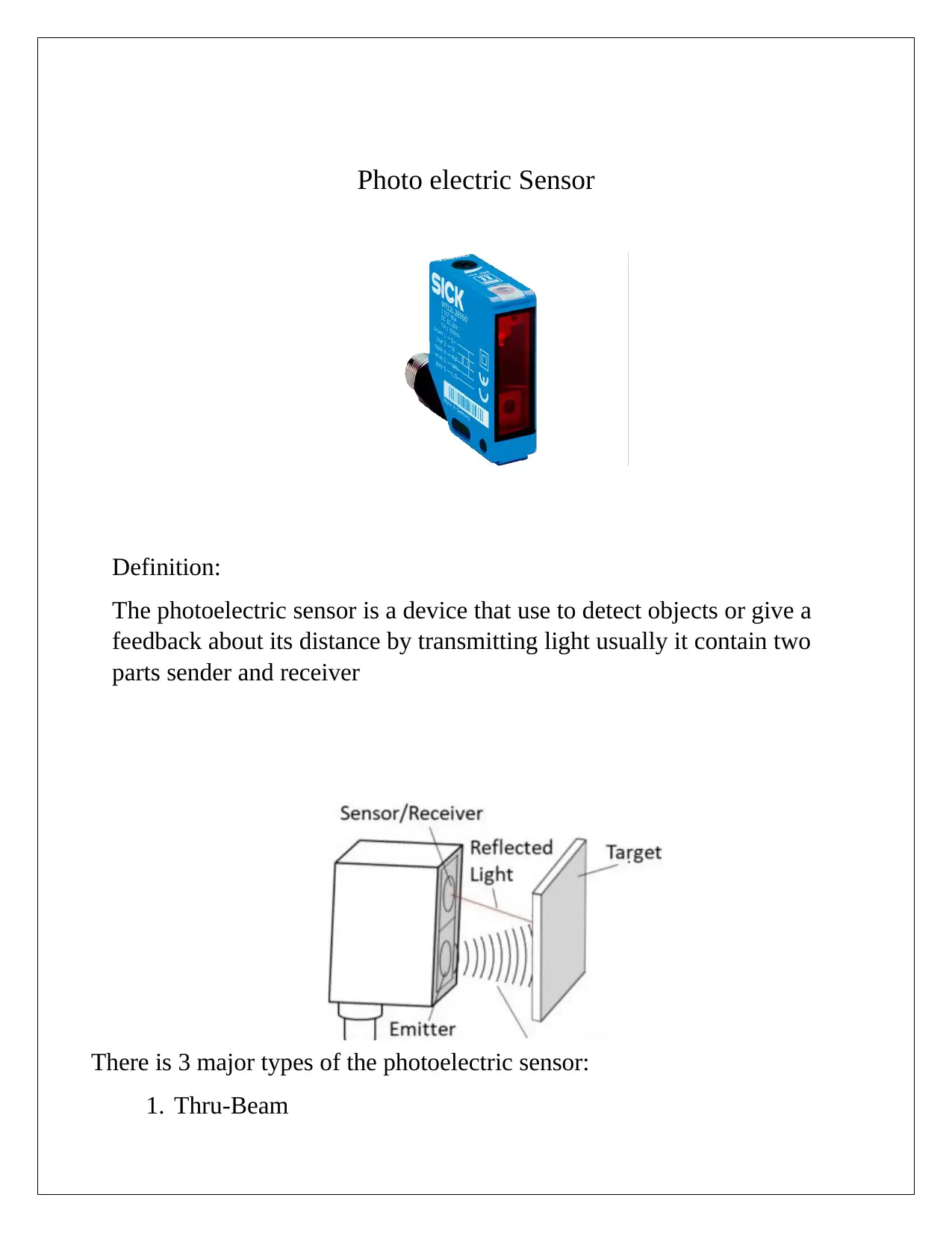
Photo electric Sensor
Definition:
The photoelectric sensor is a device that use to detect objects or give a
feedback about its distance by transmitting light usually it contain two
parts sender and receiver
There is 3 major types of the photoelectric sensor:
1. Thru-Beam
Definition:
The photoelectric sensor is a device that use to detect objects or give a
feedback about its distance by transmitting light usually it contain two
parts sender and receiver
There is 3 major types of the photoelectric sensor:
1. Thru-Beam
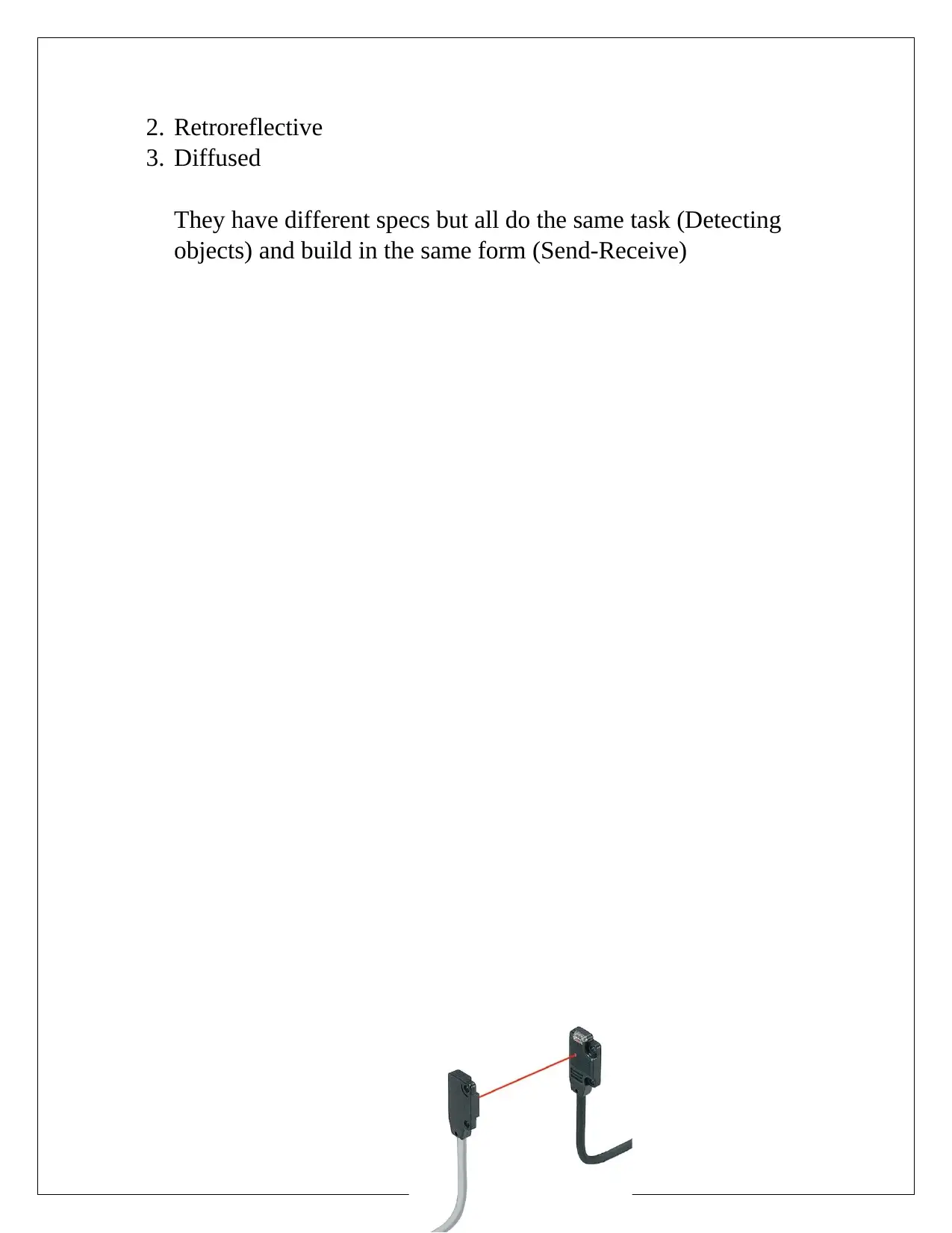
2. Retroreflective
3. Diffused
They have different specs but all do the same task (Detecting
objects) and build in the same form (Send-Receive)
Thru-Beam
3. Diffused
They have different specs but all do the same task (Detecting
objects) and build in the same form (Send-Receive)
Thru-Beam
Secure Best Marks with AI Grader
Need help grading? Try our AI Grader for instant feedback on your assignments.
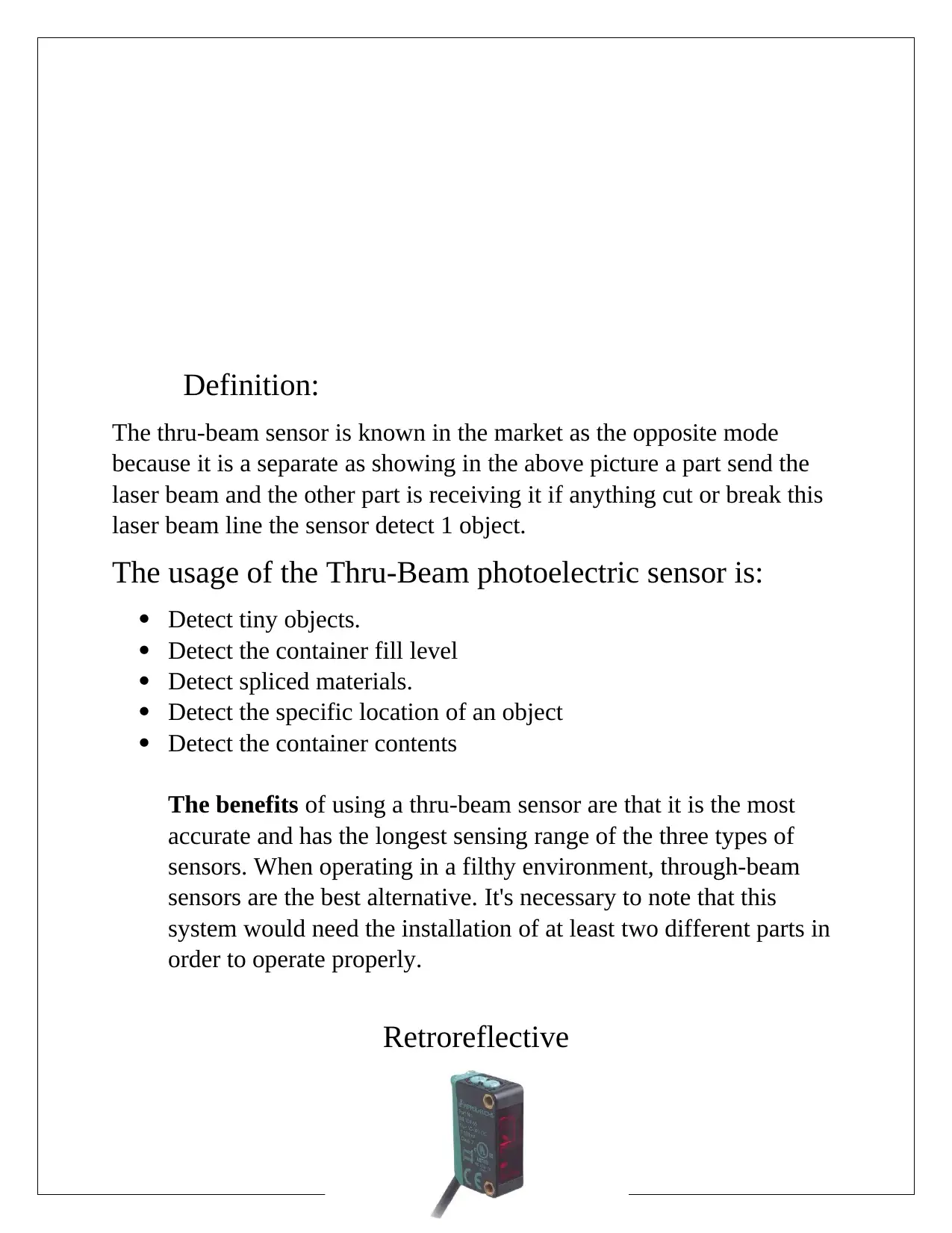
Definition:
The thru-beam sensor is known in the market as the opposite mode
because it is a separate as showing in the above picture a part send the
laser beam and the other part is receiving it if anything cut or break this
laser beam line the sensor detect 1 object.
The usage of the Thru-Beam photoelectric sensor is:
Detect tiny objects.
Detect the container fill level
Detect spliced materials.
Detect the specific location of an object
Detect the container contents
The benefits of using a thru-beam sensor are that it is the most
accurate and has the longest sensing range of the three types of
sensors. When operating in a filthy environment, through-beam
sensors are the best alternative. It's necessary to note that this
system would need the installation of at least two different parts in
order to operate properly.
Retroreflective
The thru-beam sensor is known in the market as the opposite mode
because it is a separate as showing in the above picture a part send the
laser beam and the other part is receiving it if anything cut or break this
laser beam line the sensor detect 1 object.
The usage of the Thru-Beam photoelectric sensor is:
Detect tiny objects.
Detect the container fill level
Detect spliced materials.
Detect the specific location of an object
Detect the container contents
The benefits of using a thru-beam sensor are that it is the most
accurate and has the longest sensing range of the three types of
sensors. When operating in a filthy environment, through-beam
sensors are the best alternative. It's necessary to note that this
system would need the installation of at least two different parts in
order to operate properly.
Retroreflective
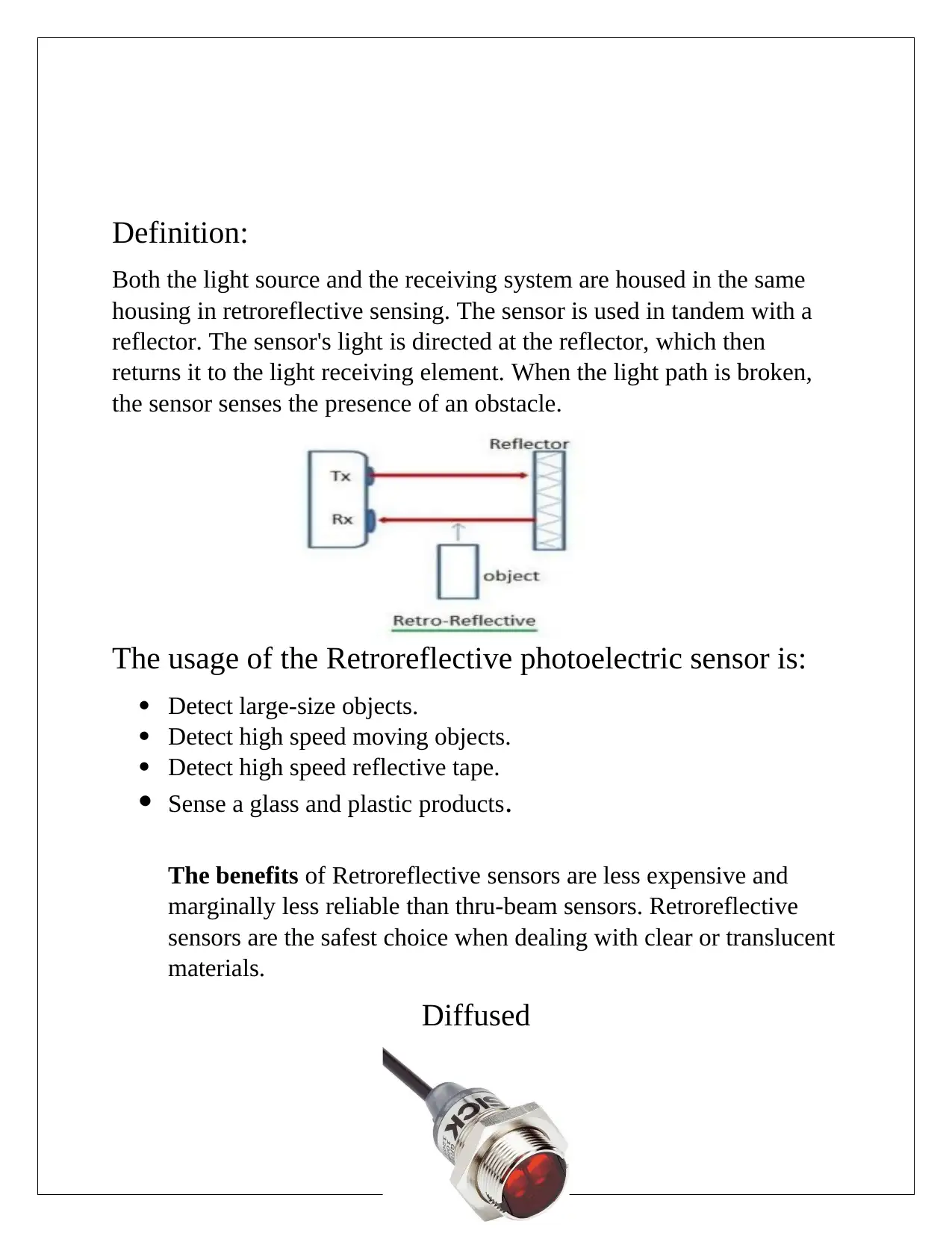
Definition:
Both the light source and the receiving system are housed in the same
housing in retroreflective sensing. The sensor is used in tandem with a
reflector. The sensor's light is directed at the reflector, which then
returns it to the light receiving element. When the light path is broken,
the sensor senses the presence of an obstacle.
The usage of the Retroreflective photoelectric sensor is:
Detect large-size objects.
Detect high speed moving objects.
Detect high speed reflective tape.
Sense a glass and plastic products.
The benefits of Retroreflective sensors are less expensive and
marginally less reliable than thru-beam sensors. Retroreflective
sensors are the safest choice when dealing with clear or translucent
materials.
Diffused
Both the light source and the receiving system are housed in the same
housing in retroreflective sensing. The sensor is used in tandem with a
reflector. The sensor's light is directed at the reflector, which then
returns it to the light receiving element. When the light path is broken,
the sensor senses the presence of an obstacle.
The usage of the Retroreflective photoelectric sensor is:
Detect large-size objects.
Detect high speed moving objects.
Detect high speed reflective tape.
Sense a glass and plastic products.
The benefits of Retroreflective sensors are less expensive and
marginally less reliable than thru-beam sensors. Retroreflective
sensors are the safest choice when dealing with clear or translucent
materials.
Diffused
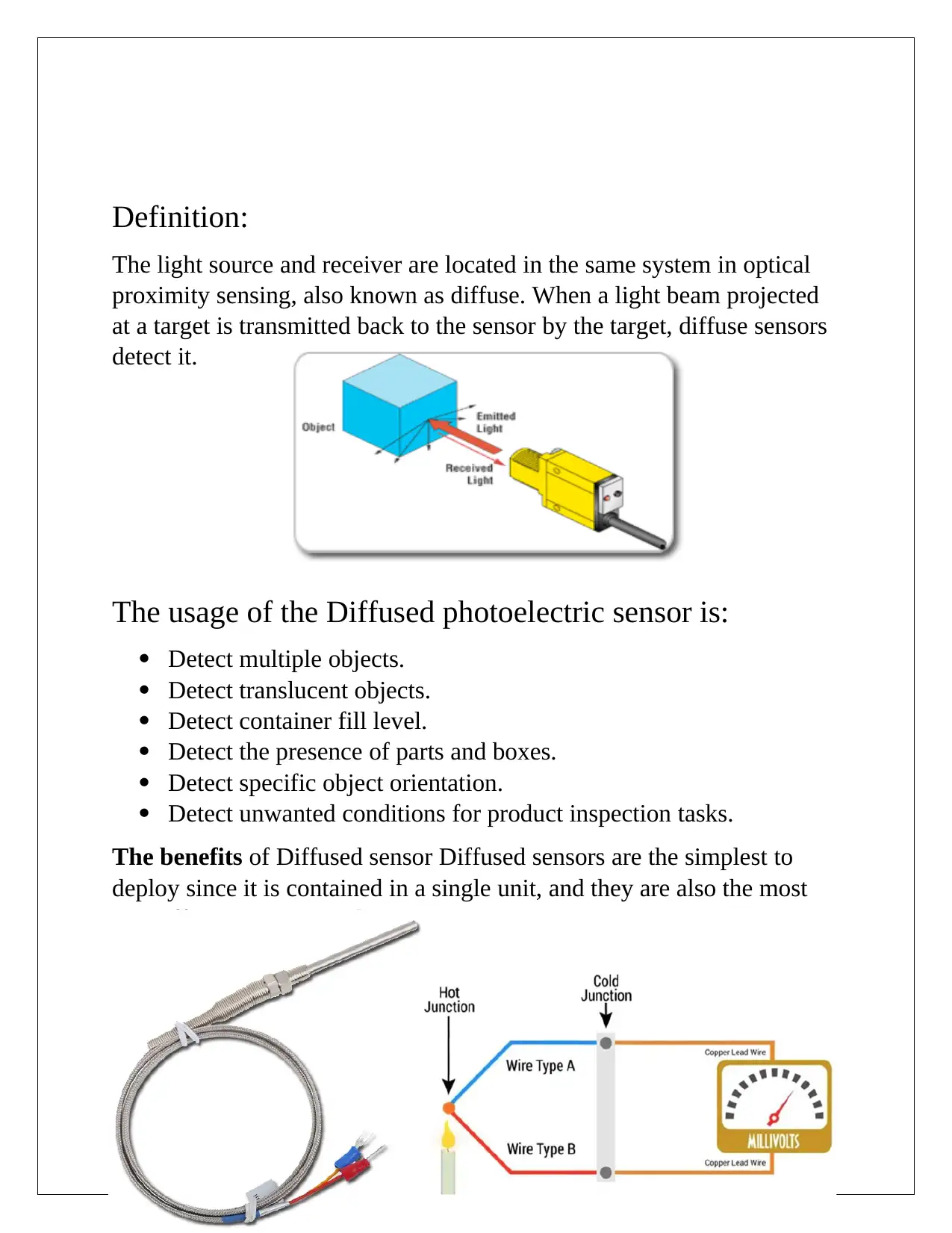
Definition:
The light source and receiver are located in the same system in optical
proximity sensing, also known as diffuse. When a light beam projected
at a target is transmitted back to the sensor by the target, diffuse sensors
detect it.
The usage of the Diffused photoelectric sensor is:
Detect multiple objects.
Detect translucent objects.
Detect container fill level.
Detect the presence of parts and boxes.
Detect specific object orientation.
Detect unwanted conditions for product inspection tasks.
The benefits of Diffused sensor Diffused sensors are the simplest to
deploy since it is contained in a single unit, and they are also the most
cost-effective sensing solution.
2. Temperature Sensor
The light source and receiver are located in the same system in optical
proximity sensing, also known as diffuse. When a light beam projected
at a target is transmitted back to the sensor by the target, diffuse sensors
detect it.
The usage of the Diffused photoelectric sensor is:
Detect multiple objects.
Detect translucent objects.
Detect container fill level.
Detect the presence of parts and boxes.
Detect specific object orientation.
Detect unwanted conditions for product inspection tasks.
The benefits of Diffused sensor Diffused sensors are the simplest to
deploy since it is contained in a single unit, and they are also the most
cost-effective sensing solution.
2. Temperature Sensor
Paraphrase This Document
Need a fresh take? Get an instant paraphrase of this document with our AI Paraphraser
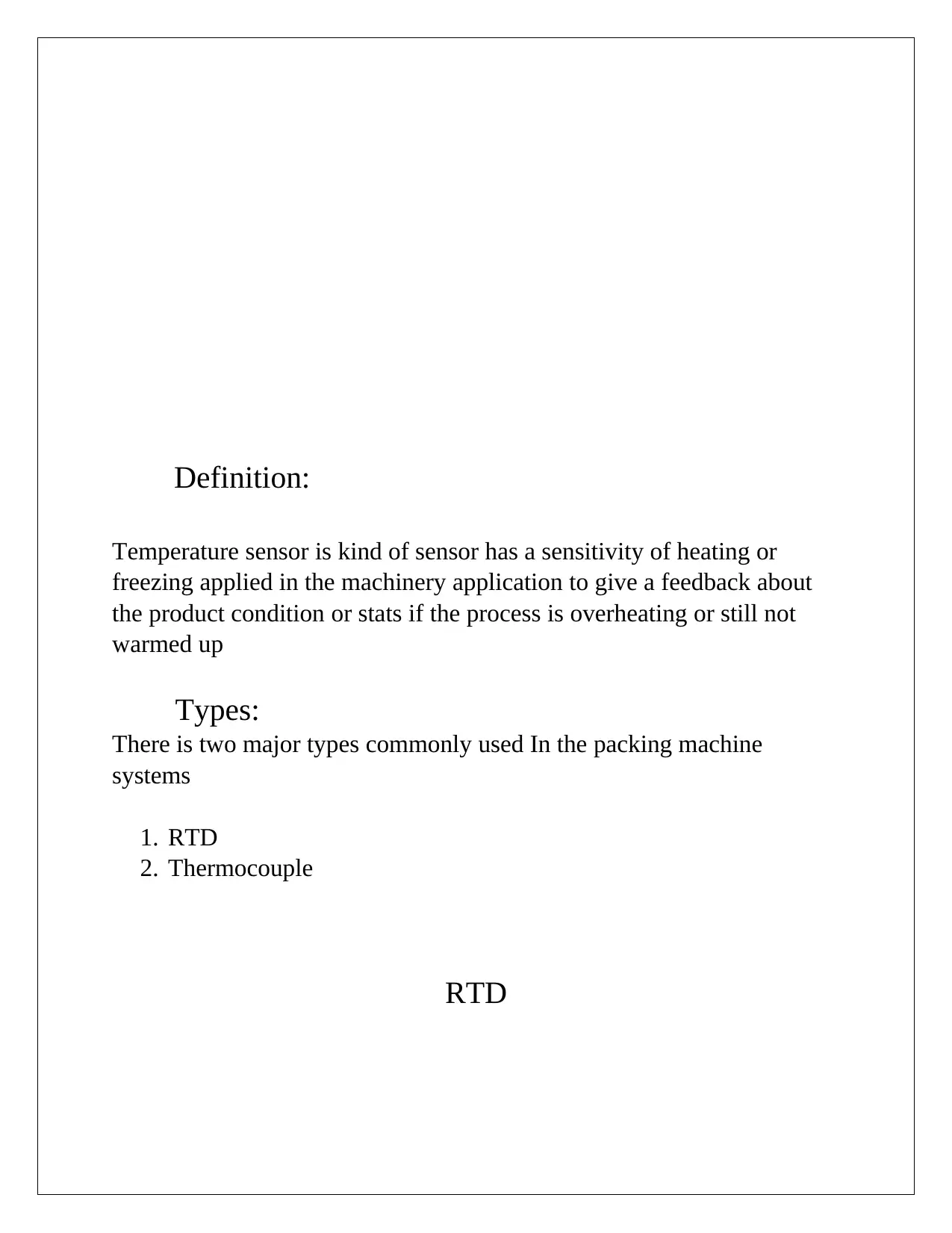
Definition:
Temperature sensor is kind of sensor has a sensitivity of heating or
freezing applied in the machinery application to give a feedback about
the product condition or stats if the process is overheating or still not
warmed up
Types:
There is two major types commonly used In the packing machine
systems
1. RTD
2. Thermocouple
RTD
Temperature sensor is kind of sensor has a sensitivity of heating or
freezing applied in the machinery application to give a feedback about
the product condition or stats if the process is overheating or still not
warmed up
Types:
There is two major types commonly used In the packing machine
systems
1. RTD
2. Thermocouple
RTD
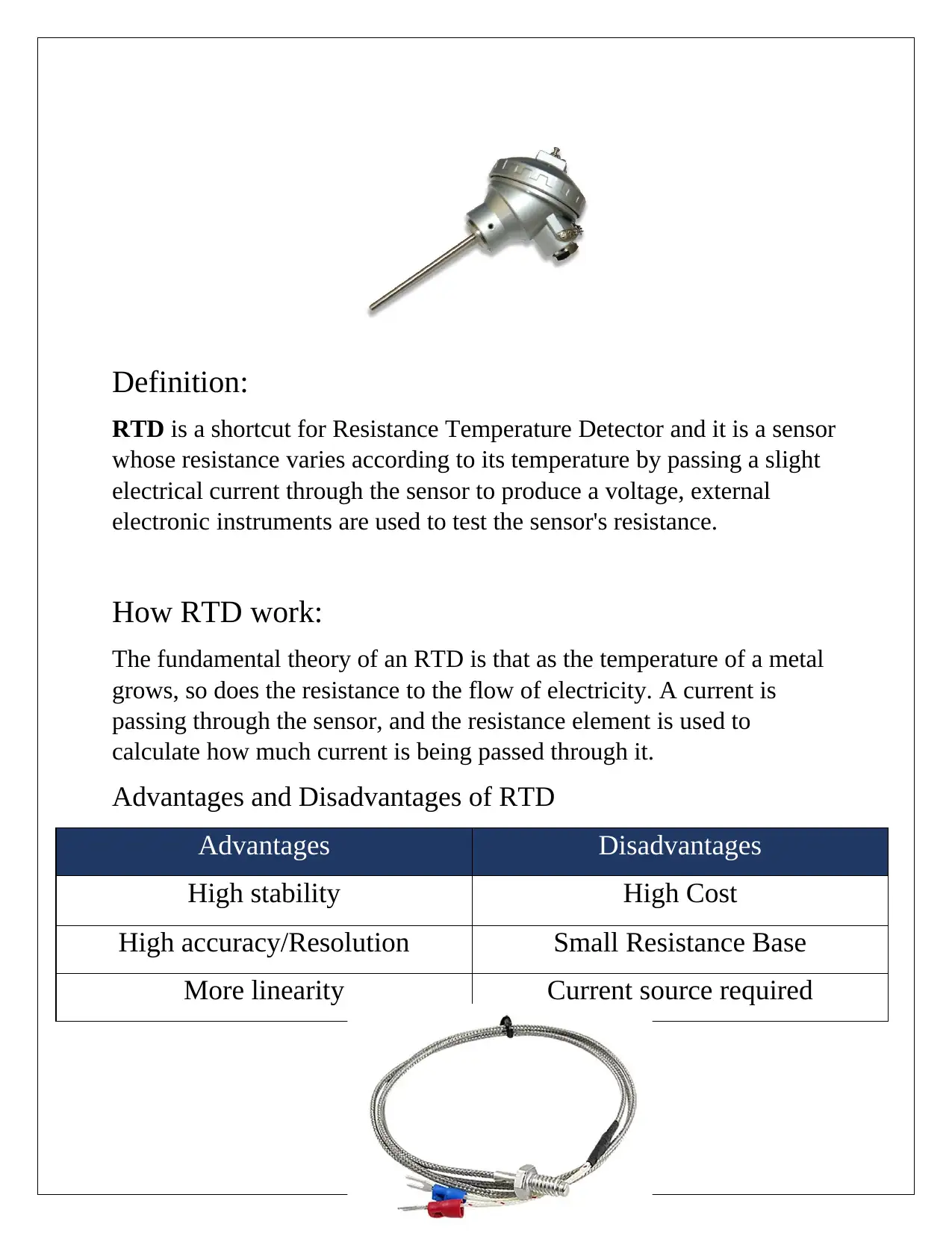
Definition:
RTD is a shortcut for Resistance Temperature Detector and it is a sensor
whose resistance varies according to its temperature by passing a slight
electrical current through the sensor to produce a voltage, external
electronic instruments are used to test the sensor's resistance.
How RTD work:
The fundamental theory of an RTD is that as the temperature of a metal
grows, so does the resistance to the flow of electricity. A current is
passing through the sensor, and the resistance element is used to
calculate how much current is being passed through it.
Advantages and Disadvantages of RTD
Advantages Disadvantages
High stability High Cost
High accuracy/Resolution Small Resistance Base
More linearity Current source required
Thermocouple
RTD is a shortcut for Resistance Temperature Detector and it is a sensor
whose resistance varies according to its temperature by passing a slight
electrical current through the sensor to produce a voltage, external
electronic instruments are used to test the sensor's resistance.
How RTD work:
The fundamental theory of an RTD is that as the temperature of a metal
grows, so does the resistance to the flow of electricity. A current is
passing through the sensor, and the resistance element is used to
calculate how much current is being passed through it.
Advantages and Disadvantages of RTD
Advantages Disadvantages
High stability High Cost
High accuracy/Resolution Small Resistance Base
More linearity Current source required
Thermocouple
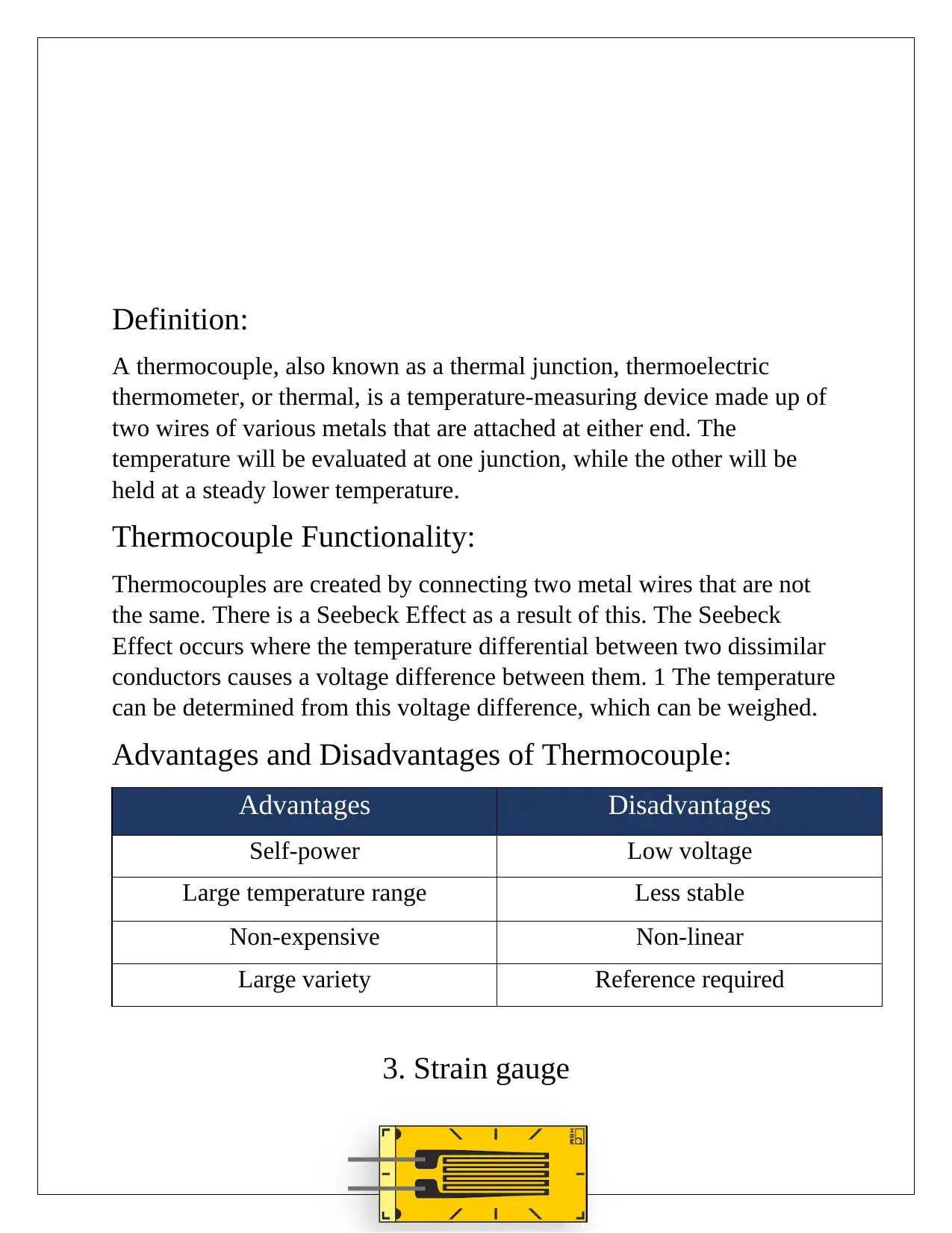
Definition:
A thermocouple, also known as a thermal junction, thermoelectric
thermometer, or thermal, is a temperature-measuring device made up of
two wires of various metals that are attached at either end. The
temperature will be evaluated at one junction, while the other will be
held at a steady lower temperature.
Thermocouple Functionality:
Thermocouples are created by connecting two metal wires that are not
the same. There is a Seebeck Effect as a result of this. The Seebeck
Effect occurs where the temperature differential between two dissimilar
conductors causes a voltage difference between them. 1 The temperature
can be determined from this voltage difference, which can be weighed.
Advantages and Disadvantages of Thermocouple:
Advantages Disadvantages
Self-power Low voltage
Large temperature range Less stable
Non-expensive Non-linear
Large variety Reference required
3. Strain gauge
A thermocouple, also known as a thermal junction, thermoelectric
thermometer, or thermal, is a temperature-measuring device made up of
two wires of various metals that are attached at either end. The
temperature will be evaluated at one junction, while the other will be
held at a steady lower temperature.
Thermocouple Functionality:
Thermocouples are created by connecting two metal wires that are not
the same. There is a Seebeck Effect as a result of this. The Seebeck
Effect occurs where the temperature differential between two dissimilar
conductors causes a voltage difference between them. 1 The temperature
can be determined from this voltage difference, which can be weighed.
Advantages and Disadvantages of Thermocouple:
Advantages Disadvantages
Self-power Low voltage
Large temperature range Less stable
Non-expensive Non-linear
Large variety Reference required
3. Strain gauge
Secure Best Marks with AI Grader
Need help grading? Try our AI Grader for instant feedback on your assignments.
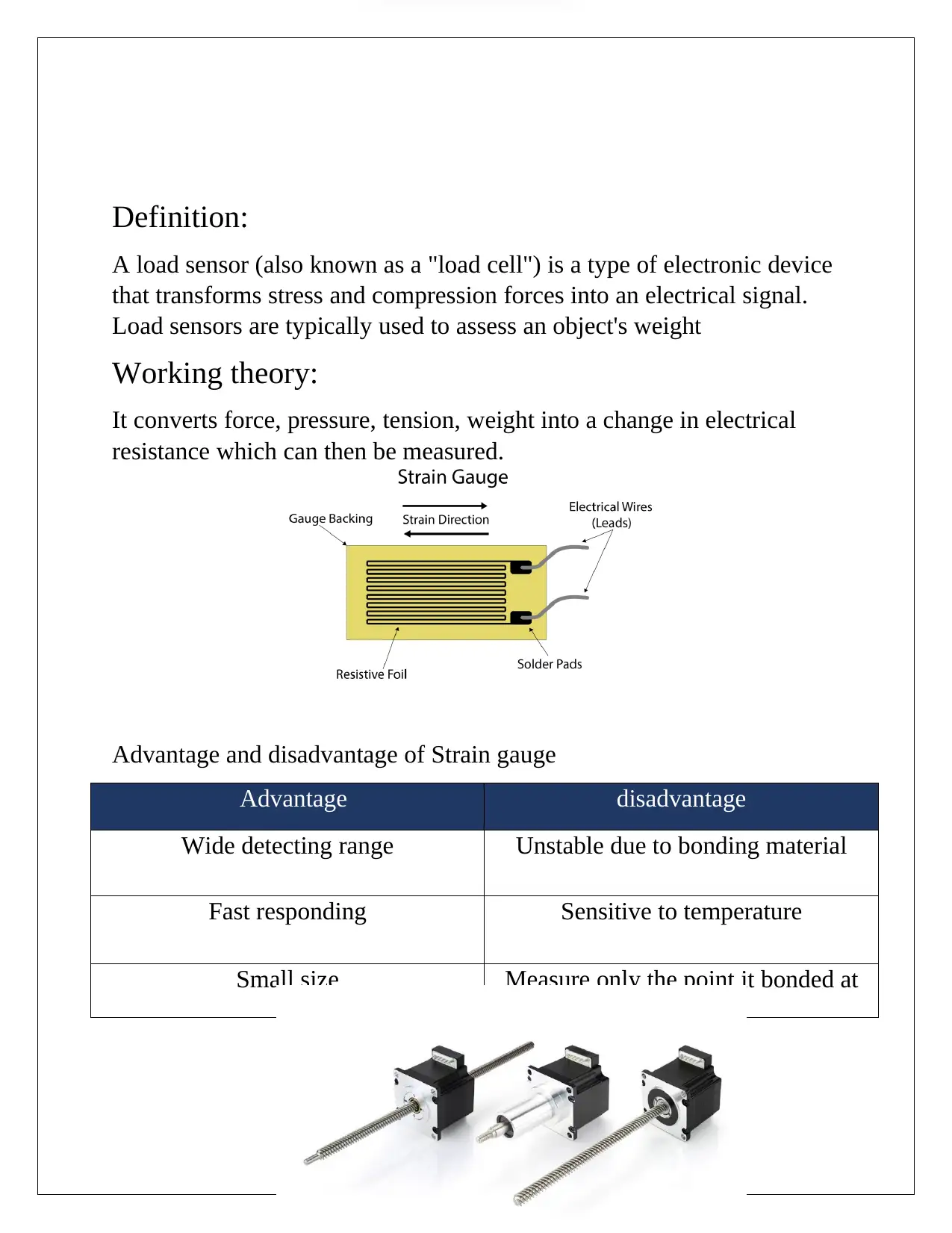
Definition:
A load sensor (also known as a "load cell") is a type of electronic device
that transforms stress and compression forces into an electrical signal.
Load sensors are typically used to assess an object's weight
Working theory:
It converts force, pressure, tension, weight into a change in electrical
resistance which can then be measured.
Advantage and disadvantage of Strain gauge
Advantage disadvantage
Wide detecting range Unstable due to bonding material
Fast responding Sensitive to temperature
Small size Measure only the point it bonded at
(2)Actuators
1. Linear Actuators
A load sensor (also known as a "load cell") is a type of electronic device
that transforms stress and compression forces into an electrical signal.
Load sensors are typically used to assess an object's weight
Working theory:
It converts force, pressure, tension, weight into a change in electrical
resistance which can then be measured.
Advantage and disadvantage of Strain gauge
Advantage disadvantage
Wide detecting range Unstable due to bonding material
Fast responding Sensitive to temperature
Small size Measure only the point it bonded at
(2)Actuators
1. Linear Actuators
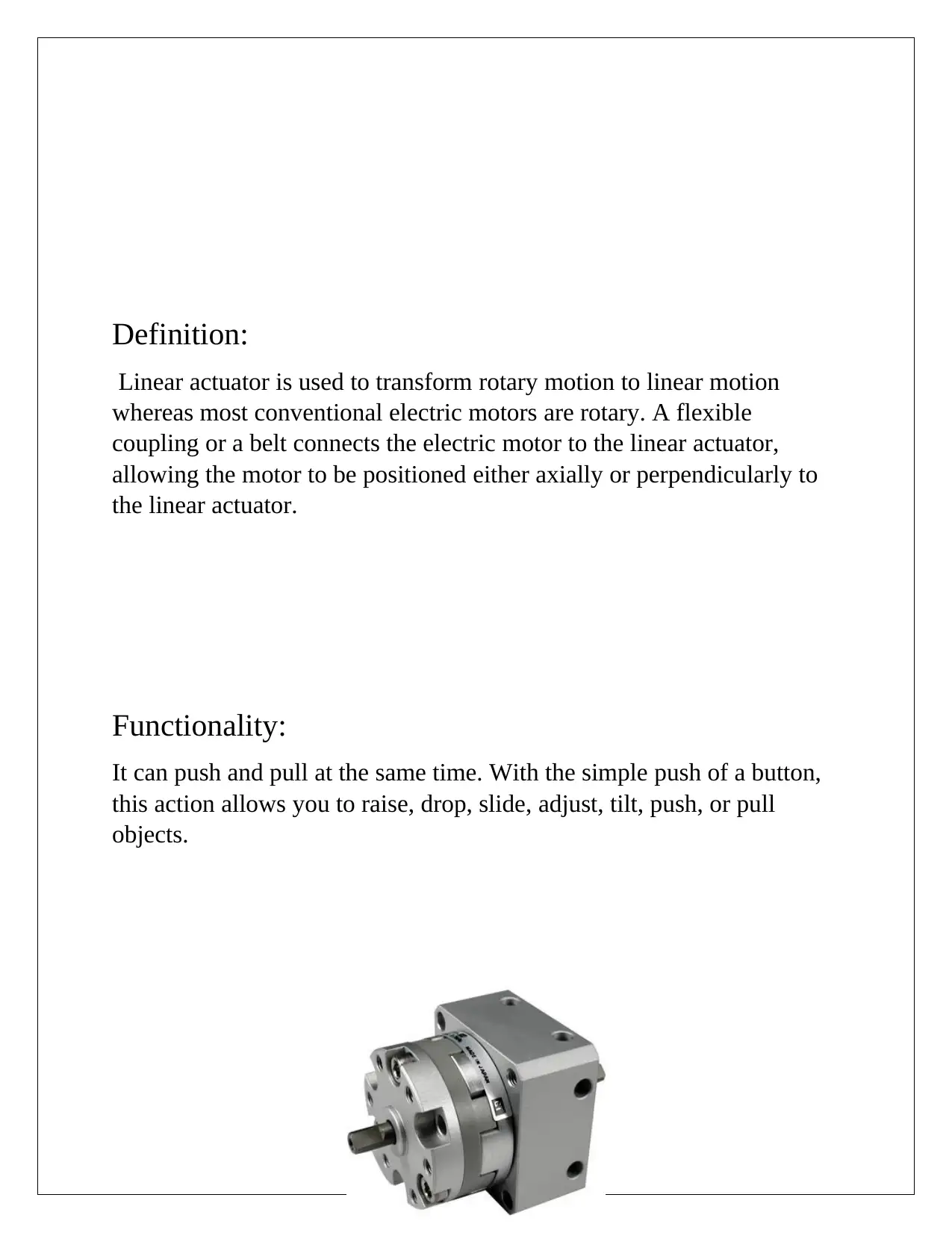
Definition:
Linear actuator is used to transform rotary motion to linear motion
whereas most conventional electric motors are rotary. A flexible
coupling or a belt connects the electric motor to the linear actuator,
allowing the motor to be positioned either axially or perpendicularly to
the linear actuator.
Functionality:
It can push and pull at the same time. With the simple push of a button,
this action allows you to raise, drop, slide, adjust, tilt, push, or pull
objects.
2. Rotary Actuator
Linear actuator is used to transform rotary motion to linear motion
whereas most conventional electric motors are rotary. A flexible
coupling or a belt connects the electric motor to the linear actuator,
allowing the motor to be positioned either axially or perpendicularly to
the linear actuator.
Functionality:
It can push and pull at the same time. With the simple push of a button,
this action allows you to raise, drop, slide, adjust, tilt, push, or pull
objects.
2. Rotary Actuator
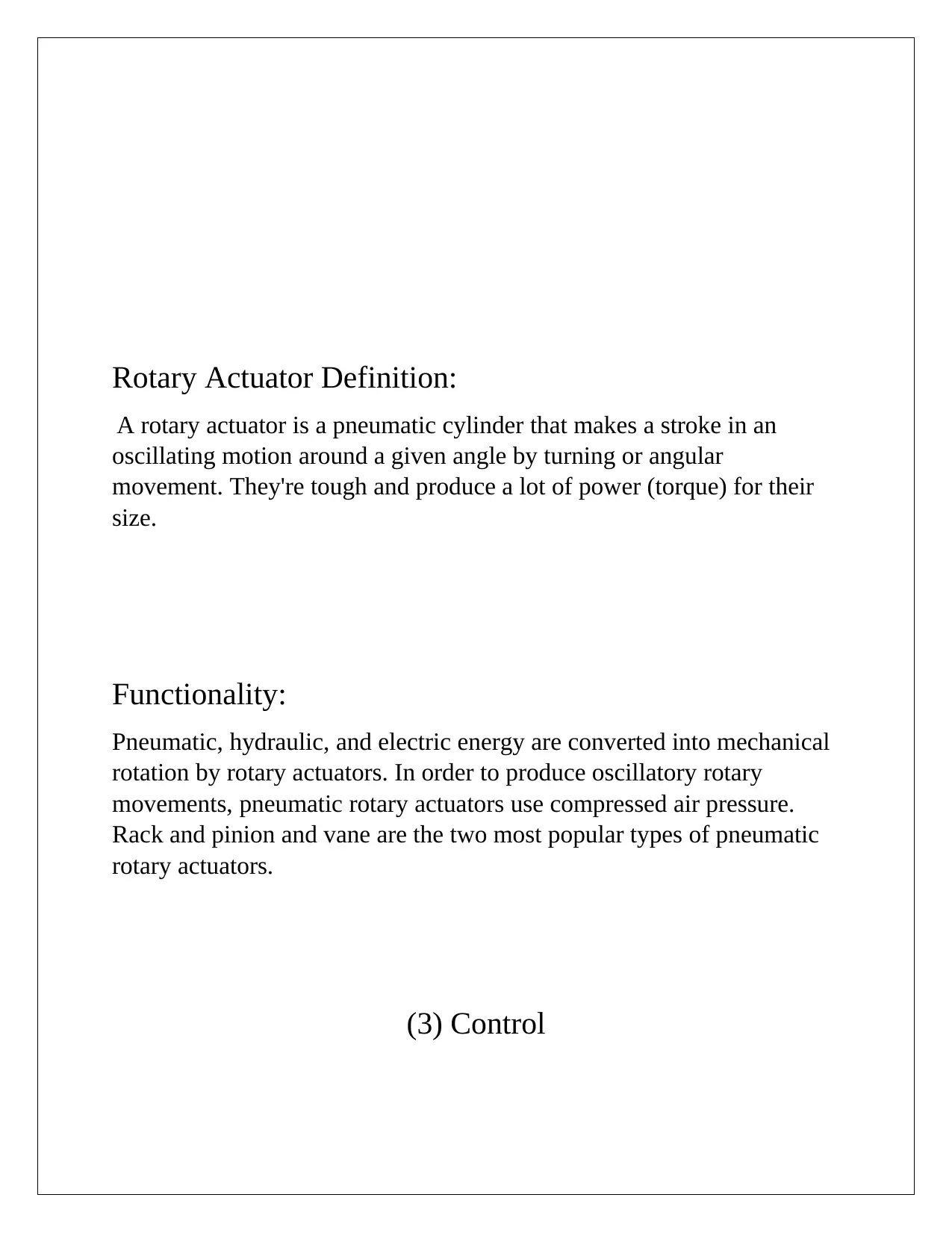
Rotary Actuator Definition:
A rotary actuator is a pneumatic cylinder that makes a stroke in an
oscillating motion around a given angle by turning or angular
movement. They're tough and produce a lot of power (torque) for their
size.
Functionality:
Pneumatic, hydraulic, and electric energy are converted into mechanical
rotation by rotary actuators. In order to produce oscillatory rotary
movements, pneumatic rotary actuators use compressed air pressure.
Rack and pinion and vane are the two most popular types of pneumatic
rotary actuators.
(3) Control
A rotary actuator is a pneumatic cylinder that makes a stroke in an
oscillating motion around a given angle by turning or angular
movement. They're tough and produce a lot of power (torque) for their
size.
Functionality:
Pneumatic, hydraulic, and electric energy are converted into mechanical
rotation by rotary actuators. In order to produce oscillatory rotary
movements, pneumatic rotary actuators use compressed air pressure.
Rack and pinion and vane are the two most popular types of pneumatic
rotary actuators.
(3) Control
Paraphrase This Document
Need a fresh take? Get an instant paraphrase of this document with our AI Paraphraser
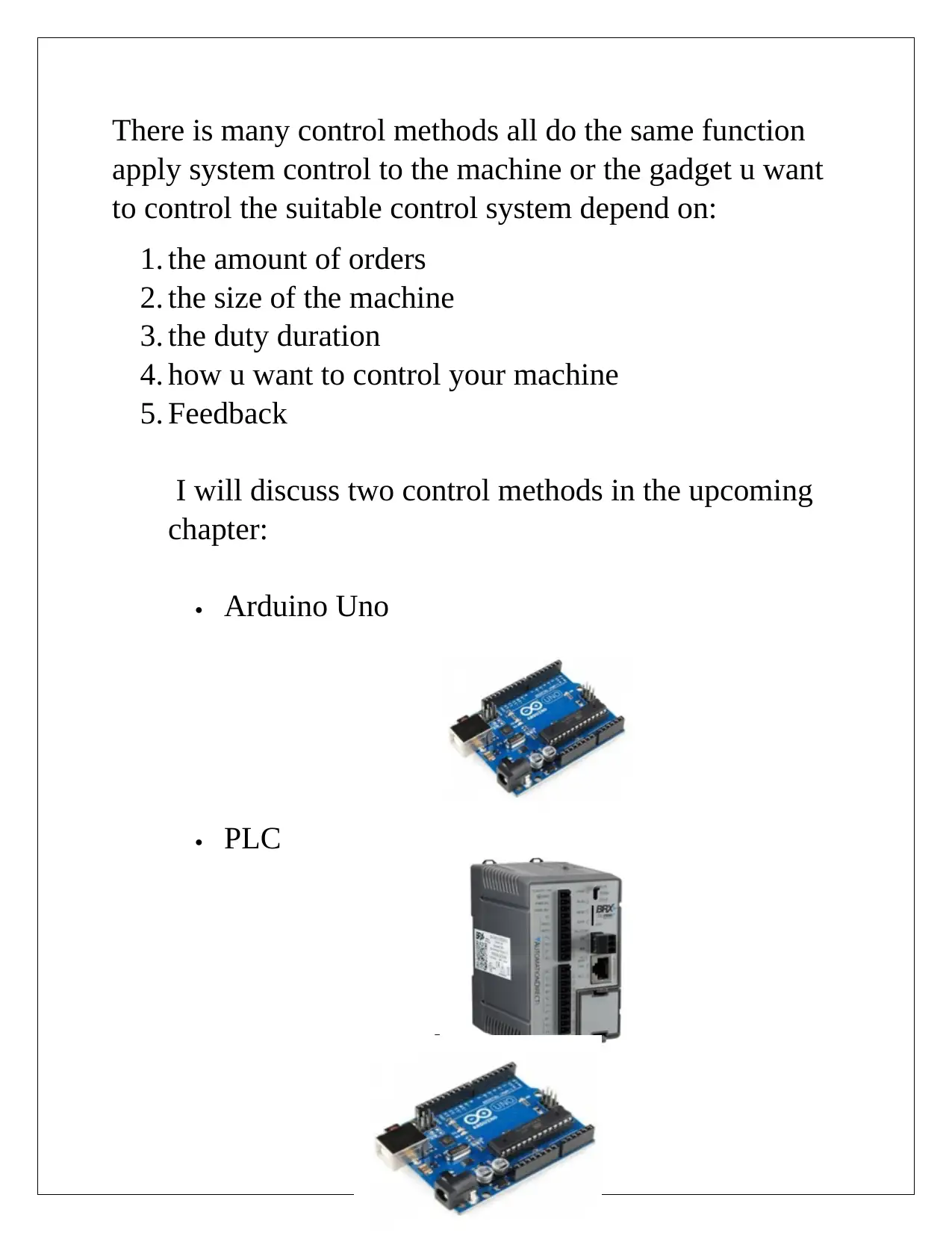
There is many control methods all do the same function
apply system control to the machine or the gadget u want
to control the suitable control system depend on:
1. the amount of orders
2. the size of the machine
3. the duty duration
4. how u want to control your machine
5. Feedback
I will discuss two control methods in the upcoming
chapter:
Arduino Uno
PLC
Arduino Uno
apply system control to the machine or the gadget u want
to control the suitable control system depend on:
1. the amount of orders
2. the size of the machine
3. the duty duration
4. how u want to control your machine
5. Feedback
I will discuss two control methods in the upcoming
chapter:
Arduino Uno
PLC
Arduino Uno
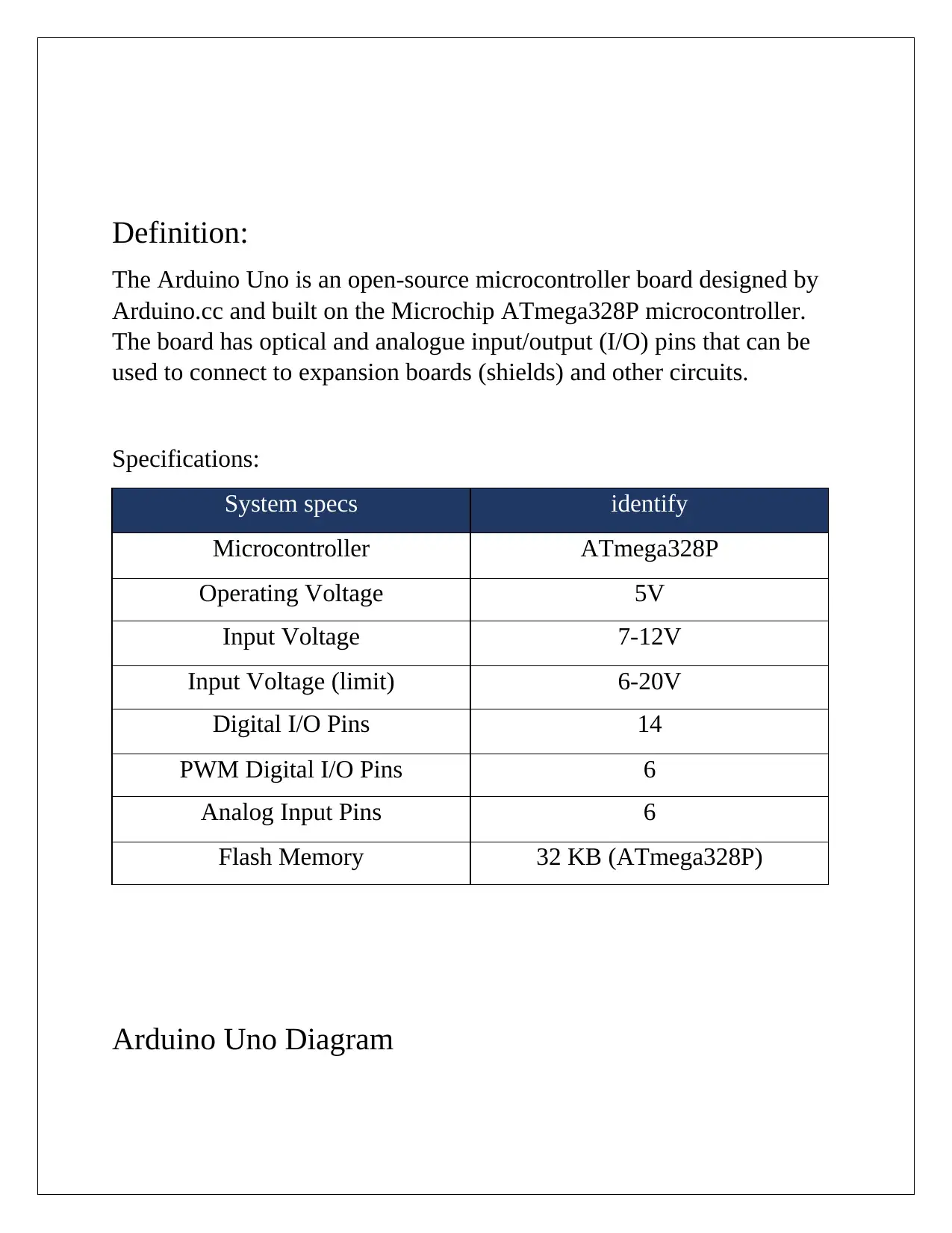
Definition:
The Arduino Uno is an open-source microcontroller board designed by
Arduino.cc and built on the Microchip ATmega328P microcontroller.
The board has optical and analogue input/output (I/O) pins that can be
used to connect to expansion boards (shields) and other circuits.
Specifications:
System specs identify
Microcontroller ATmega328P
Operating Voltage 5V
Input Voltage 7-12V
Input Voltage (limit) 6-20V
Digital I/O Pins 14
PWM Digital I/O Pins 6
Analog Input Pins 6
Flash Memory 32 KB (ATmega328P)
Arduino Uno Diagram
The Arduino Uno is an open-source microcontroller board designed by
Arduino.cc and built on the Microchip ATmega328P microcontroller.
The board has optical and analogue input/output (I/O) pins that can be
used to connect to expansion boards (shields) and other circuits.
Specifications:
System specs identify
Microcontroller ATmega328P
Operating Voltage 5V
Input Voltage 7-12V
Input Voltage (limit) 6-20V
Digital I/O Pins 14
PWM Digital I/O Pins 6
Analog Input Pins 6
Flash Memory 32 KB (ATmega328P)
Arduino Uno Diagram
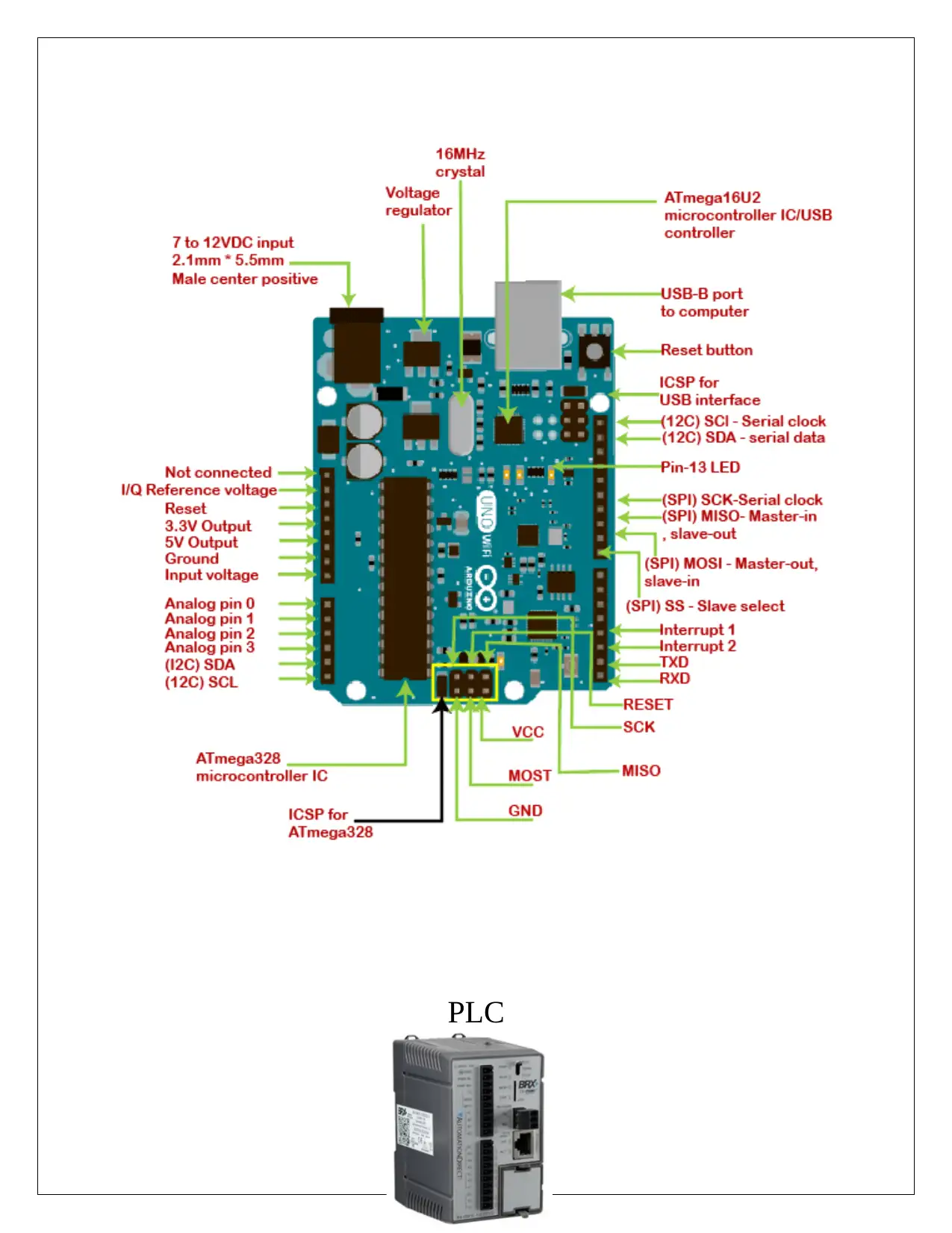
PLC
Secure Best Marks with AI Grader
Need help grading? Try our AI Grader for instant feedback on your assignments.
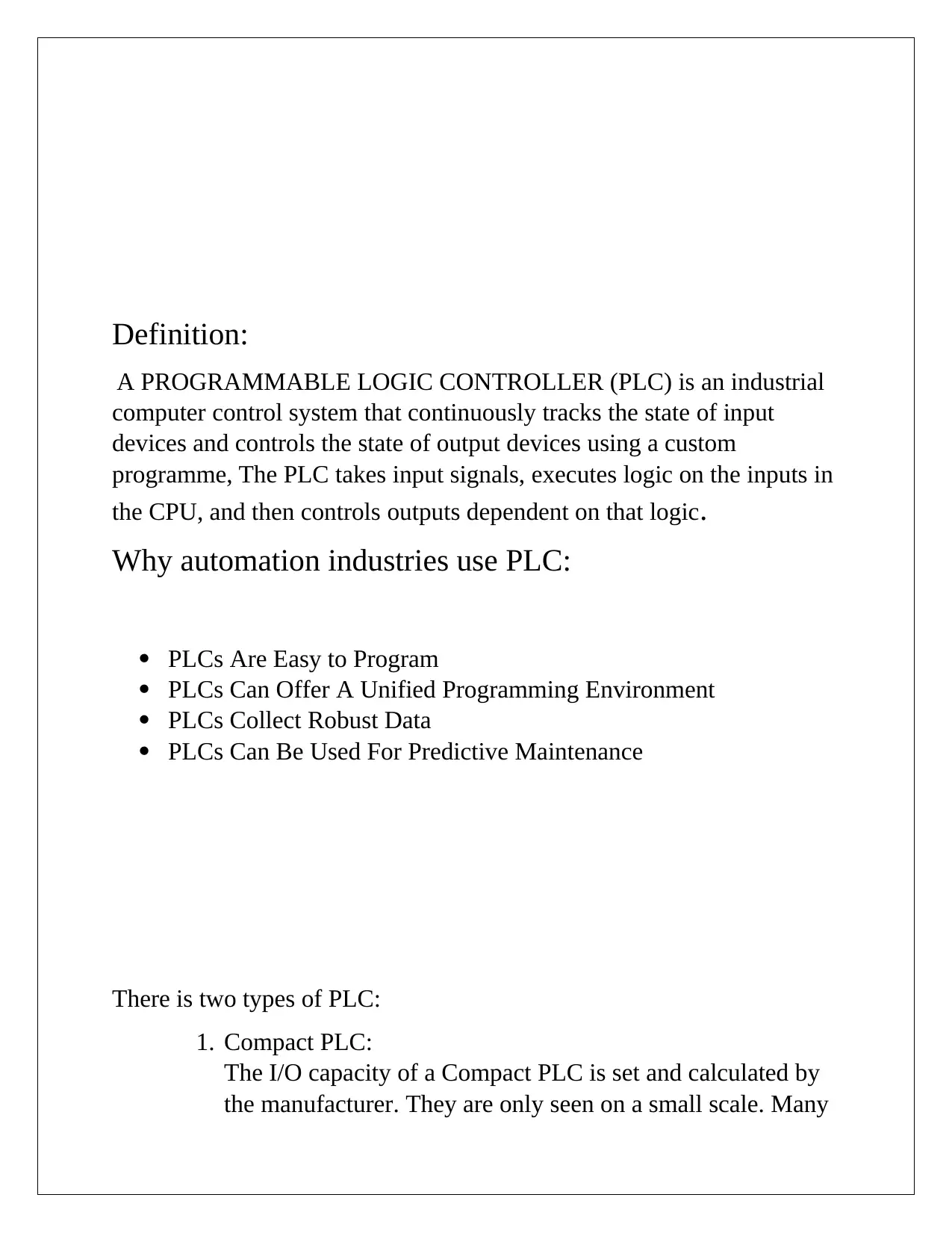
Definition:
A PROGRAMMABLE LOGIC CONTROLLER (PLC) is an industrial
computer control system that continuously tracks the state of input
devices and controls the state of output devices using a custom
programme, The PLC takes input signals, executes logic on the inputs in
the CPU, and then controls outputs dependent on that logic.
Why automation industries use PLC:
PLCs Are Easy to Program
PLCs Can Offer A Unified Programming Environment
PLCs Collect Robust Data
PLCs Can Be Used For Predictive Maintenance
There is two types of PLC:
1. Compact PLC:
The I/O capacity of a Compact PLC is set and calculated by
the manufacturer. They are only seen on a small scale. Many
A PROGRAMMABLE LOGIC CONTROLLER (PLC) is an industrial
computer control system that continuously tracks the state of input
devices and controls the state of output devices using a custom
programme, The PLC takes input signals, executes logic on the inputs in
the CPU, and then controls outputs dependent on that logic.
Why automation industries use PLC:
PLCs Are Easy to Program
PLCs Can Offer A Unified Programming Environment
PLCs Collect Robust Data
PLCs Can Be Used For Predictive Maintenance
There is two types of PLC:
1. Compact PLC:
The I/O capacity of a Compact PLC is set and calculated by
the manufacturer. They are only seen on a small scale. Many
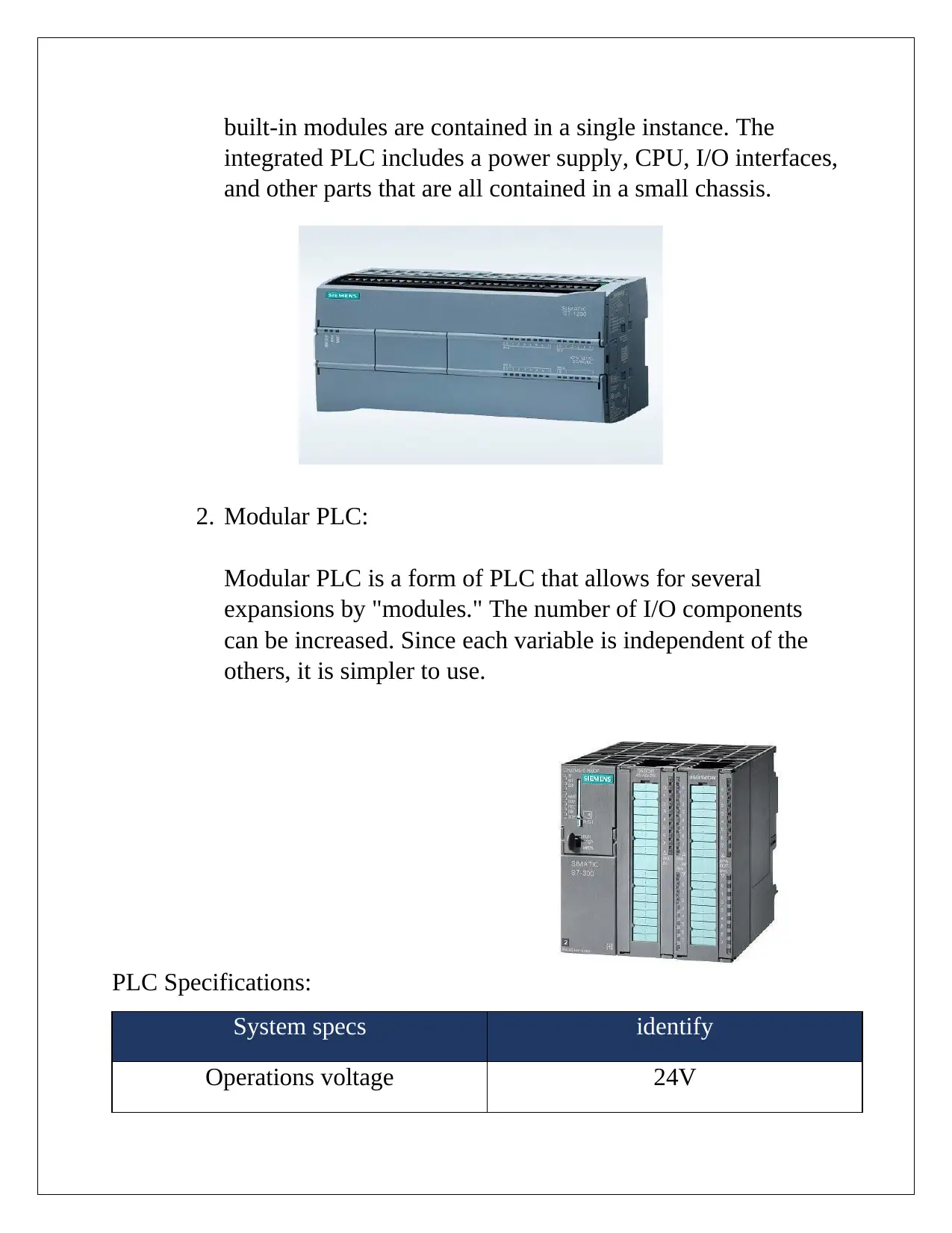
built-in modules are contained in a single instance. The
integrated PLC includes a power supply, CPU, I/O interfaces,
and other parts that are all contained in a small chassis.
2. Modular PLC:
Modular PLC is a form of PLC that allows for several
expansions by "modules." The number of I/O components
can be increased. Since each variable is independent of the
others, it is simpler to use.
PLC Specifications:
System specs identify
Operations voltage 24V
integrated PLC includes a power supply, CPU, I/O interfaces,
and other parts that are all contained in a small chassis.
2. Modular PLC:
Modular PLC is a form of PLC that allows for several
expansions by "modules." The number of I/O components
can be increased. Since each variable is independent of the
others, it is simpler to use.
PLC Specifications:
System specs identify
Operations voltage 24V
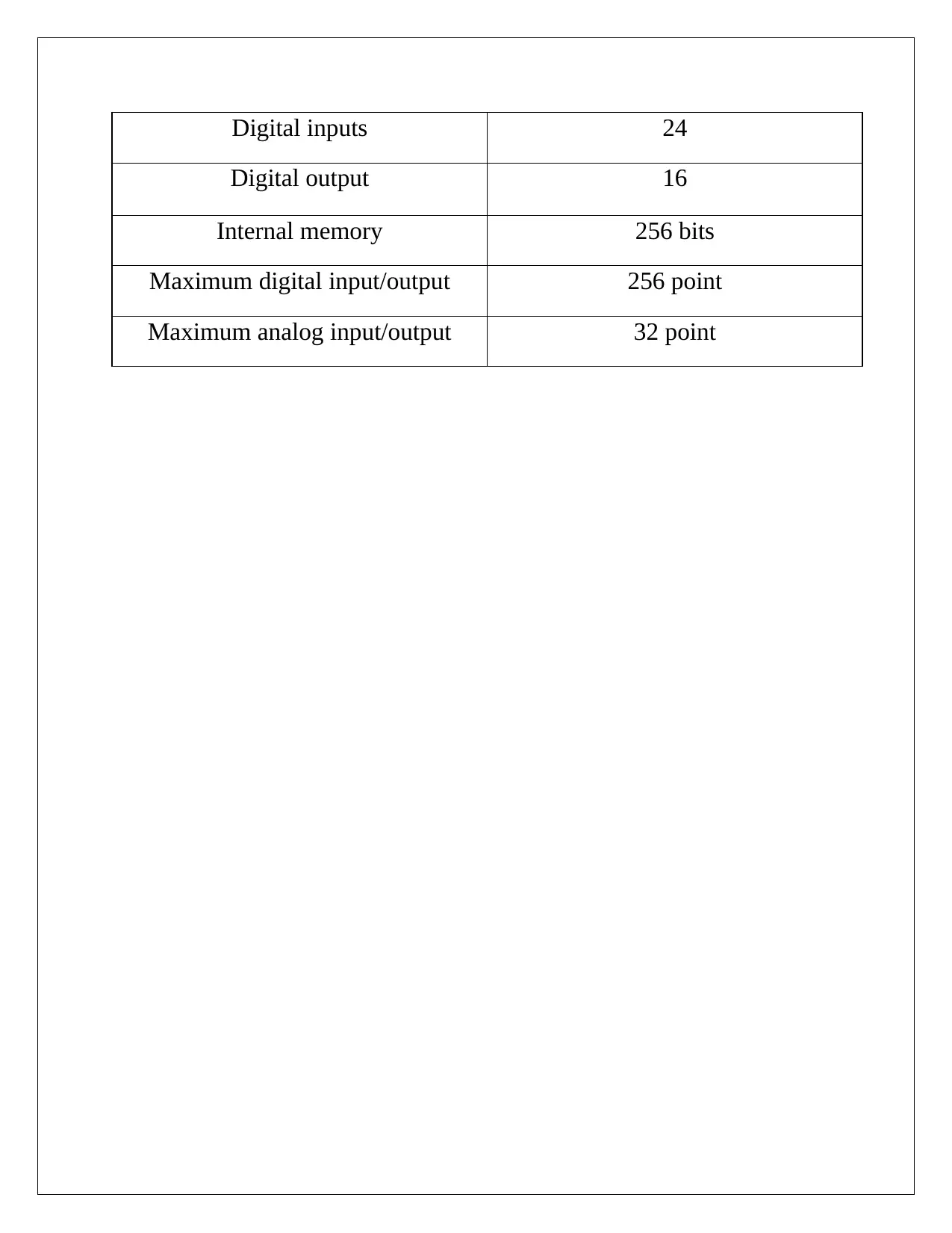
Digital inputs 24
Digital output 16
Internal memory 256 bits
Maximum digital input/output 256 point
Maximum analog input/output 32 point
Digital output 16
Internal memory 256 bits
Maximum digital input/output 256 point
Maximum analog input/output 32 point
1 out of 25
Your All-in-One AI-Powered Toolkit for Academic Success.
+13062052269
info@desklib.com
Available 24*7 on WhatsApp / Email
![[object Object]](/_next/static/media/star-bottom.7253800d.svg)
Unlock your academic potential
© 2024 | Zucol Services PVT LTD | All rights reserved.